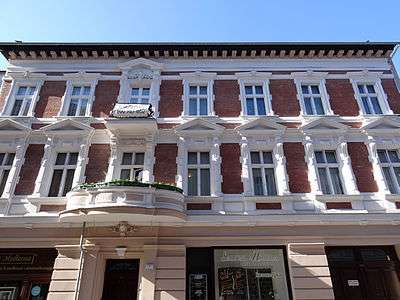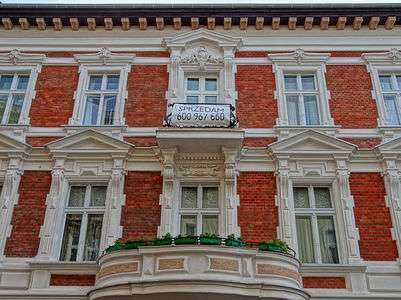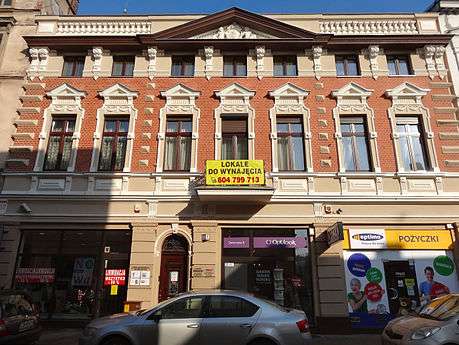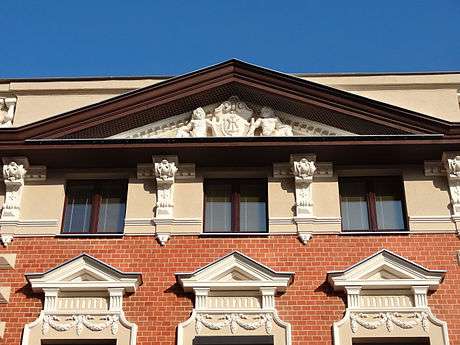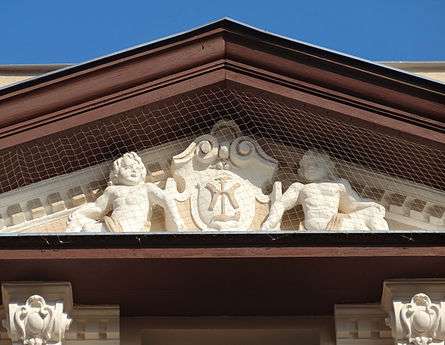Dworcowa Street in Bydgoszcz
| Bydgoszcz | |
|---|---|
| <span class="nickname" ">Polish: Ulica Dworcowa w Bydgoszczy | |
|
View in the vicinity of N°39 | |
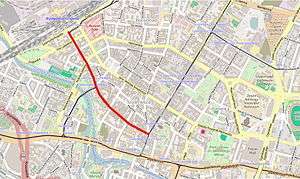 | |
| Former name(s) | Bahnhoffstraße - Dworcowa - Albert-Forsterstraße |
| Namesake | Main Station |
| Owner | City of Bydgoszcz |
| Length | 1.24 km (0.77 mi) |
| Area | Downtown Bydgoszcz |
| Location | Bydgoszcz |
| Wikimedia Commons has media related to Dworcowa Street in Bydgoszcz. |
Dworcowa Street is one of the main streets of Bydgoszcz, in Downtown district (Polish: Śródmieście).
Across the street, between Warmia and Marcinkowski street runs the 18°E longitude Meridian, so-called Bydgoszcz Meridian.[1][2]
Location
The street is located in the western part of Downtown Bydgoszcz. It runs from the intersection with Gdanska Street to the intersection with Sigismund Augustus Street, where is the main train station, Bydgoszcz Główna.
Hence its name: "Train station" in polish is "Dworzec", "Dworcowa Street" thus means "Train Station Street".
History
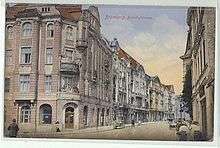
Until 1851, the path was a dirty road leading from Bydgoszcz to Koronowo. The development of the street is associated with the building of Bydgoszcz Main Railway Station in 1851, which led to assimilating the close settlement of Bocianowo (German: Brenkenhoff) into the city precinct.[3]
On a 1861 map of the area, the vicinity of the railway station shows dispersed housings: it is only in the early 20th century that compact constructions make their appearance along the street. Some specific quarters near Gdanska street and close to the Main station have shown earlier activity, with the development of hotel buildings:[4]
- Hotel "Pod Orlem" (1893), Hotel Pawlikowski (1898) in Gdanska Street;
- Hotel du Nord (1875), Heises's Hotel (1884), Schliep's Hotel (1889) near the Main Station.
At the end of the XIXth, the street had an industrial and commercial character. In its surroundings flourished trade houses, craft workshops and restaurants or bars. The industrial buildings and warehouses occupied the area between the street and the Brda river, while along the street were located flats and shops. The largest companies in Dworcowa street (then "Bahnhoffstraße") were:[5]
- Fabryka Sygnałów Kolejowych (Railway Signals Factory),
- J.G. Neumann's Brick factory (German: Ziegelfabrik)[6]
- Printhouse Ortis (established by Hermann and Emil Dittmann)[7] They published the "Deutsche Rundschau", and after World War II all the local newspapers.[8]
Between 1890 and 1914, many houses along the street have been transformed into 3 to 4 storey buildings, displaying ornated facades,[9] turning the venue into one of the most representative in the city.[10] In the final section of the street near the Main Railway Station, there were five hotels, furnished as tenements.[4]
Street trams have been operated since 1888, first horse powered, then electrical ones in 1896. The line ("Red") ran along the entire length of the street from Main Railway Station to Gdanska Street; in 1948, line designation was changed to "A".
In 1990, tram traffic has been suspended for technical reasons. Since then a partial restoration of the line has been performed after the revitalization of the street.[11]
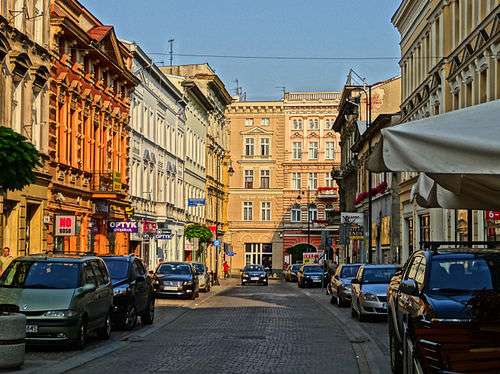
Appellation
Through history, this street had the following names:[12]
- 1852-1920 - Bahnhoffstraße (Main Station street in German)
- 1920-1939 - Ulica Dworcowa (Main Station street in German)
- 1939-1945 - Albert-Forsterstrasse (named after nazi leaderAlbert Forster)
- From 1945 - Ulica Dworcowa
Famous residents
- Marian Rejewski - cryptologist who broke the Enigma code during World War II;
- Andrzej Jan Szwalbe (1923-2002), lawyer, Polish social and cultural activist and organizer of musical life in Bydgoszcz, since 1993. Honorary Citizen of Bydgoszcz. He was the founder and creator of numerous artistic projects;
- Heinrich Böll - Nobel Prize-winning writer, who lived there in 1940;
- Alojzy Błażyński (1898-1934) - a pilot and flight instructor, who became famous for his daring escape from the German army in 1919.

Characteristics
Dworcowa Street is 1242 m long,[5] and is almost entirely built with stylish houses. It is considered as one of the most important axis, historically and functionally in downtown Bydgoszcz. Its architectural landscape is quite diverse, with houses of different scale and style coexisting together.
For the most part, street facades display architectural features fashionable in the years 1860-1914:[13]
Oldest buildings have been built in Neoclassical style, usually with simple, symmetrical facades and modest decorations. In the last quarter of the 19th century, elements of Neo-Renaissance, Neo-Gothic and Neo-Baroque start to appear on houses.[13] Most impressive buildings have been erected in the 1900-1915 period: it was the emergence of breaking architectural styles, such as Historicism, Secession and early Modern architecture.[13]
From 1886 to 1889 has been built the Prussian Eastern Railway Headquarters, which was at the time the most magnificent public property in the entire city.
Dworcowa street has got outstanding works of local and Berlin's architects. However, the two major ones -Joseph Święcicki and Fritz Weidner- who built 29 edifices in Gdanska Street, only designed four buildings in Dworcowa.
Most noticeable tenements are located on the southern side of the street: 3 buildings are registered on the Heritage List since 2010.[14]
Most prominent buildings include:
- Former Prussian Eastern Railway Headquarters;
- State Archives Building at N°65;
- Tax House at Warminski St.18;
- Hotels [15]
- Former "Asystenta " at N°79;
- "Centralny" at N°85;
- "Hotel Brda" (built in 1968-1972).
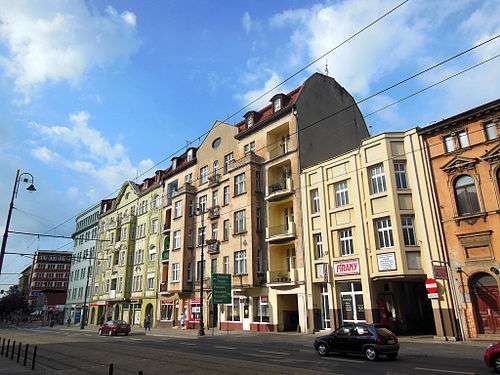
Revitalisation
Dworcowa Street being one of the most important streets of Downtown Bydgoszcz, has been the target of a vast revitalisation plan.
In 2009, in the Local Plan for the Revitalization of Bydgoszcz has been included the project "Revitalisation of Dworcowa street". Costs amount to 6.4 million zł, helped by an EU funding (4.2 million zł) under the 2007-2013 Regional Operational Programme for Kuyavian-Pomeranian Voivodeship.[16] The project comprised:
- the modernization of Dworcowa street with a pedestrian pavement,
- the addition of greens,
- the landscaping on the section between Gdanska Street and Matejki street.
In addition, the section leading from Matejki street to Main Railway Station has seen the restoration of trams circulation, and the refurbishment of a historic building by Fritz Weidner in the immediate vicinity, converted to a Municipal Cultural Center.[16][17]
Means of transportation
Since 2012, tram lines N°5 and N°8 run on the section from Matejki street to Sigismund Augustus street, using a special bridge built for the occasion.[18]
In addition, bus lines (54, 67, 75, 71, 79, 80, 83, 84, 31N, 33N) run on the section between Main train station and Królowej Jadwigi street.
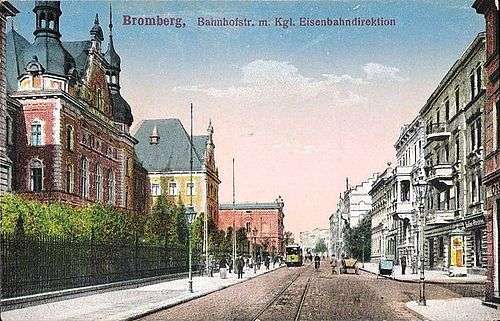
Main edifices
Department store "Jedynak", crossing with Gdańska Street N°15
Registered on Kuyavian-Pomeranian Voivodeship heritage list, N°601296-reg.87/A, 10 December 1971[19]
1910-1911, by Otto Walter
One of the first Department Store built in Bydgoszcz, it pioneered the use of reinforced concrete in a modern design.
- Department Store "Jedynak"
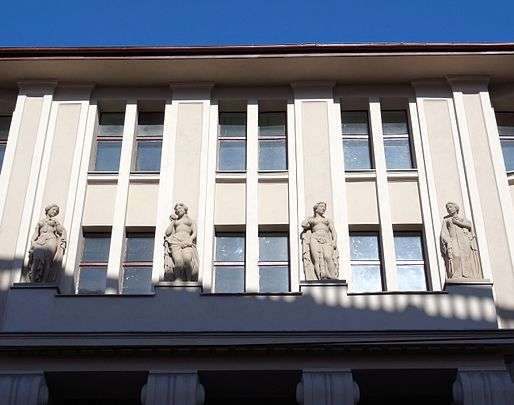 Allegories on the facade
Allegories on the facade
Tenement at N°2, corner with Pomorska Street N°1
1884,[20] by Karl Bergner
This corner house has been commissionned by Mr Jäfel, a lithograph.[21] In 1908, a drugstore run by Dr Aurel Kratz opened there: he was also selling goods for cameras[22] until World War I. He then moved to Friedrichstraße.[23]
The building is on a triangular footprint plot, a challenge for the designer. It displays a nice bay window on the corner facade. The first floor windows, around the bay-window are more adorned than others with flanking pilasters topped with corbels and a frieze of ornaments. The second floors windows are capped by triangular pediments and have also small corbels and pilasters. The 3rd level openings are only flanked by clean pilasters and pediment topped. A line of designed corbels runs beneath the roof.
 Facade onto Pomorska Street
Facade onto Pomorska Street View from Gdańska Street
View from Gdańska Street
Tenement at N°3
1877, by Carl Stampehl
Eduard Merres,[24] a instrument craftsman for surgery, nursery and optics, was the first owner of the current house, then located at Bahnhoffstraße 2. In 1907, the new owner was Mr. Conitzer,[25] a businessman member of the very family running at that time the neighbouring department store.
The facade has been restored in 2015, giving more sharpness to all the different details. It is almost a classical one, but for the assymmetry: on first level, one notice heavily adorned windows (triangle pediments, pilasters with consoles, the second floor is less decorated and topped by a dense Corbel table. The gate axis is stressed by a monumental balcony and a smaller one above. The entry door transom is crowned by a delicately carved female figure.
Tenement at N°4
1887,[20] by Józef Święcicki
Julius and Herß Krojanter,[26] were the first owners of the house at Bahnhoffstraße 97: they were cereals merchants and had their counter in the building. In the 1920s, the tenement housed a kitchenware shop, A. Hensel".
The facade lost all its original adornements during renovation. However, the row of square windows on the top witnesses the original Neoclassical features.
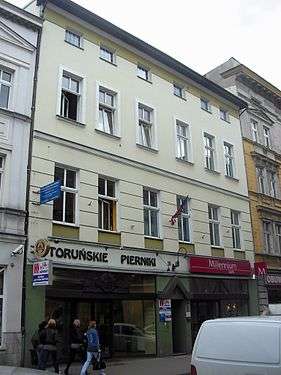 Facade on Dworcowa Street
Facade on Dworcowa Street Advertising for "A. Hensel" shop (1925)
Advertising for "A. Hensel" shop (1925)
Tenement at N°5
Mid-19th century[20]
Amelie Sieg, a rentier and widow of a mason,[27] was the first owner of the tenement in the 1870s. From the 1900s (decade) till World War I, the new owner, Ernst Knitter, was a merchant selling kitchenware and ironmongery.[28]
The elevation has been renovated in 2015, underlying the delicacy of the ornamentation: the front pediment, the gate frame with its two facing figures, the pilasters and the corbel table.
- Main elevation
- Detail of the facade
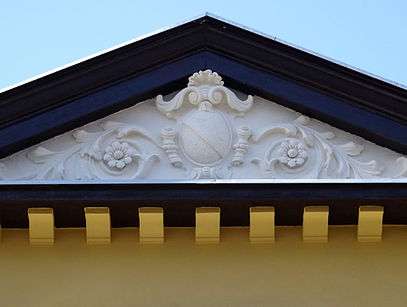 View of the main pediment
View of the main pediment
Tenement at N°6
ca 1875-1900
A baker, Wilhelm ßiehl, was the first landlord of the house in 1869, which address was then Bahnhoffstraße 96.[29] He lived there until World War I.
The facade displays Neoclassical elements: symmetry, smooth wall, ornamented windows for each floor, small openings at the top of the elevation, topped with a corbel table, and a small stone balcony.
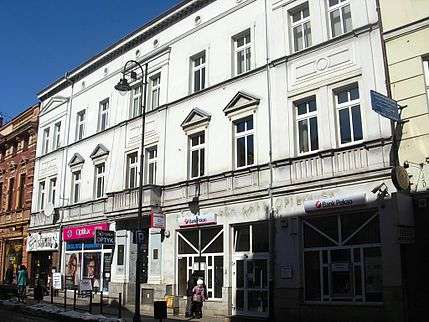 Facade on Dworcowa Street
Facade on Dworcowa Street
Tenement at N°7
ca 1875-1900
Gabriel Czalla was the first owner of the house at Bahnhoffstraße 4[30]
The symmetrical facade lost its initial ornaments during the 20th century. However, one can still appreciate the overall disposition, with the slight avant-corps underlining the axis of the entry gate, flanked by high pilasters continuing to the first floor.
 Facade on Dworcowa Street
Facade on Dworcowa Street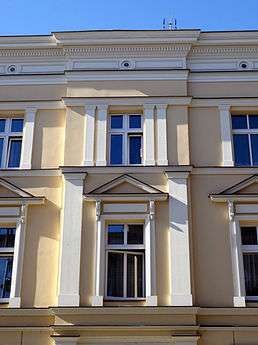 Detail of the avant-corps
Detail of the avant-corps
Karl Lachmann Tenement, Dworcowa Street N°8
1893-1906
The building is marked on its tympanum by the initials of its commissioner, "KL" for Karl Lachmann The young, a rich butcher,[31] who had its shop there, at Bahnhoffstraße 95a, until the 1910s. In 1910, a small hotel named "Bertuhn Ella" was set up there[32]
The facade has been refurbished in 2015. Many elements are remarkable: the wall bossages, the richly adorned window pediments or the decorated corbels. Most of all, the highest part of the building draws attention, with a balustrade and a pediment with a tympanum, in which allegorical sculptures are placed.
Otto Pfefferkorn tenement, Dworcowa Street N°12
1909, by Fritz Weidner
Otto Pfefferkorn owned a successful furniture factory in Bromberg,[33] which still exists today.[34] He used this house as his selling shop, and had many more built in the city (Gdańska Street, Theatre square),[33] none of them survived. In 1912, the building was awarded city most beautiful facade![35]
Most of the architectural details of the facade have unfortunately vanished. Be that as it may, one can make out the assymmetry of the elevation, characteristic of Fritz Weidner. He used bow windows unbalanced positions, balconies at different levels and with different shapes to reach his goals.
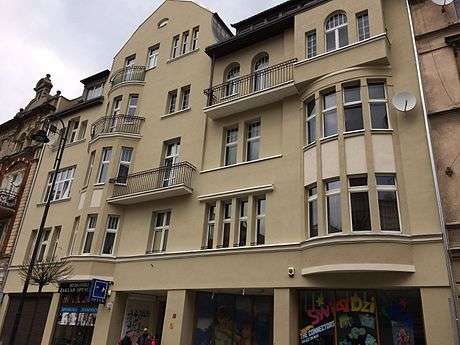 Facade on Dworcowa Street
Facade on Dworcowa Street Facade before restoration
Facade before restoration
Apro building, Dworcowa Street N°13
2011, by Danuta Jarosewski[36]
The building has been realized in the frame of the revitalization of Dworcowa street. In the early 20th century, the plot was the site of a printhouse owned by A. Dittmann.
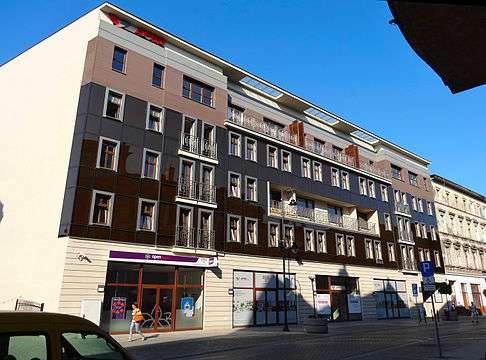 Facade on Dworcowa Street
Facade on Dworcowa Street
Tenement at N°14
1899[20]
The first owner of this house, then at Bahnhoffstraße 93, was Ernst Schmidt, a merchant. He stayed there until World War I.[37] After 1900, it housed the seat of engineering firm Weidlich & Berthold"[38]
Neo-Renaissance features of the building (arched windows, pediments, low roof), could almost be called Neo-baroque by the choice of volute shaped motifs for the wrought iron balconies, or the roof pediment.
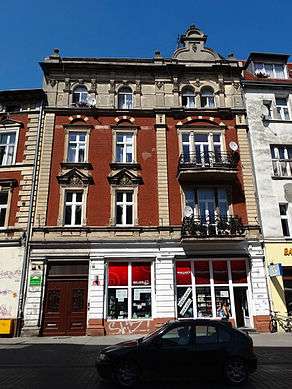 Facade onto Dworcowa Street
Facade onto Dworcowa Street Detail of the roof pediment
Detail of the roof pediment- Detail of window decoration
Tenement at N°16
1875[20]
Ferdinand Th. Zorn, a wood manufacturer and merchant, at Bahnhoffstraße 92[39] was the first owner of the tenement. He kept it till World War I.
The style and shape of the facade is clearly echoing the one at N°14. However, it displays clearly Neo-Renaissance characteristics. Motifs are neat, each floor has a specific window adornament, the slight bay window stresses the symmetry of the elevation. One can notice the minute ornamentation of this bay-window (niches, balustrade, volutes) as well as the corbel table at the top.
 Facade on Dworcowa Street
Facade on Dworcowa Street
Tenement at N°17
Second half of 19th century
First owner of the building at Bahnhoffstraße 6 was Wilhelm Schönfelder.[40] In 1888, Hermann Löhnert moved here as landlord: he was the founder and director of a joint-stock company of a factory producing machines for foundries,[41] established in 1868[42] in Bydgoszcz. The firm still exists today, under the name Makrum, located at Leśna street 11-19.[43]
Although lacking maintenance, the facade still boasts architectural details. Pediments on first floor windows, but also bossages are present. The most interesting decoration is the adornament surrounding middle openings on both floors: pilasters and garland ornaments are topped on the upper floor by crown ornaments.
- main elevation
- Windows decoration detail
Tenement at N°19, corner with Dr Emilia Warminskiego Street
Registered on Kuyavian-Pomeranian Voivodeship heritage list, N°601287-Reg.A/968, November 12, 1992[19]
1880[20]
Friedrish Giese, a brewer at Bahnhoffstraße 7a[44] was the first owner of the house. In 1910, the building became an hotel, "Reichshof", run by Carl Müller.[45] In 1922, it changed to "Goplana", run by Jan Gawron,[46] then "Boston". From 1932 to 1939, it has been renamed "Gastronomia" with led by H. Katorski.[47] It is now a habitation building.
The building -although worn in many places of its facade- shows a nice decoration on the first floor, with pediments topping windows and ornamented cartouche beneath, as well as a row of round openings below the roof. The main feature is the grand two-floor stretched bay window standing on streets corner.
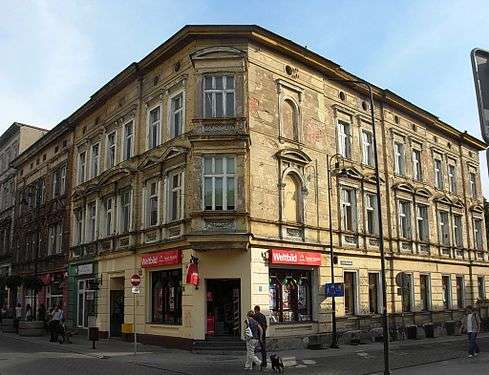 Corner view of the building
Corner view of the building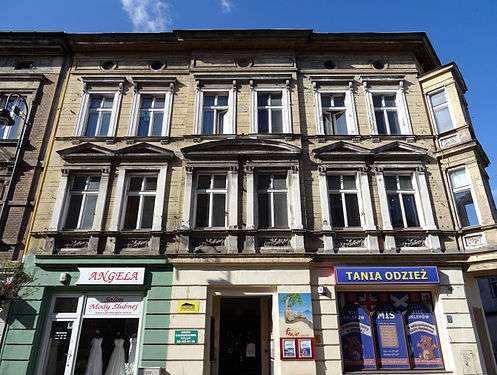 Elevation on Dworcowa street
Elevation on Dworcowa street- Gate and door recess
Tenement at N°22
circa 1875[20]
Gottschalck family owned Bahnhoffstraße 89 since 1876.[48] In the 1900s (decade), Hermann Albrecht, a merchant became the owner: at that time he also possessed the tenement at N°20 and at at Warmiński Street 18.[49] Since 1990 is located here one of the first pizzeria in Bydgoszcz (Pizzeria Ambar).
The main elevation shows nice architectural details: a large wrought iron balcony overlooking a delicate wrought iron entry gate, pediments on first floor windows, corbels on the second floor and arch topped windows in the middle of the facade.
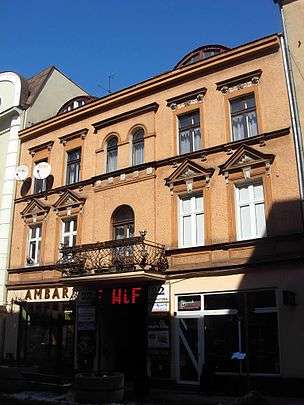 Facade on Dworcowa Street
Facade on Dworcowa Street- Detail of the gate and balcony
Tenement at Warmiński Street 18, corner with Dworcowa Street
1905[20]
First time mentioning the building at Bahnhoffstraße 88 was in 1872, when Hermann Burow, a backer, was the owner.[50] In 1890, August Hoffmann set up there a butcher shop(German: Fleischerei und Wurst-Fabrik).[51] During the interwar period, it has been the local seat of the National Bank of Poland. It is now the seat of Bydgoszcz Tax Office .
The building recently renovated is a nice showcase of Art Nouveau architecture in Bydgoszcz: round shapes (dormers, gate, windows), vegetal motifs on the elevation, the bay windows and assymmetry of both facades.
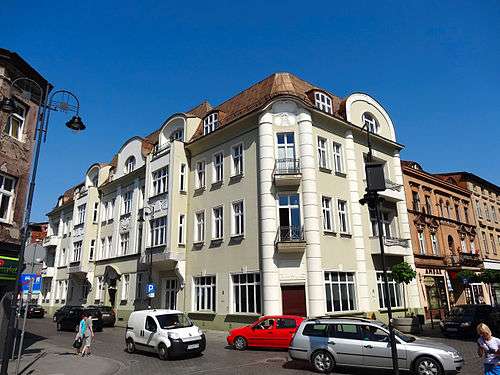 Facades view from street crossing
Facades view from street crossing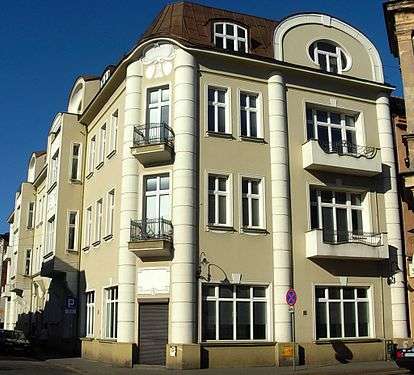 Facade on Dworcowa Street
Facade on Dworcowa Street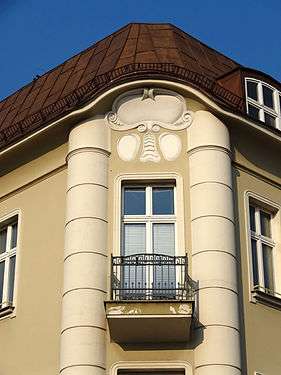 Detail of corner facade
Detail of corner facade- Detail of the gate
Tenement at N°25
1894[20]
The tenement at Bahnhoffstraße 10 is in the family of locksmithes since at least 1855: Carl, then Otto are its owners.[52] It is the latter who had the house rebuilt to the present style,[53] in which he lived till 1910. In 1935, the place housed a store run by R. B. Reimann, selling Philips radio parts.[54]
The style of the facade is close to the Neo-Renaissance, with its symmetry in the windows and wrought ironbalconies positions, the table corbel on top of a row of small upper squared openings. Pediments are remarkably adorned by floral motifs, as well as pilasters.
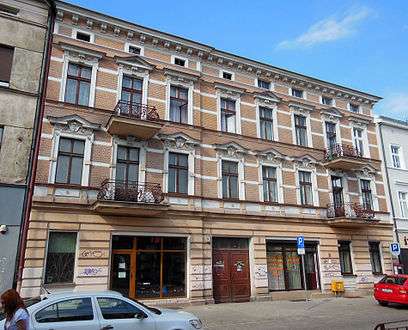 Facade on Dworcowa Street
Facade on Dworcowa Street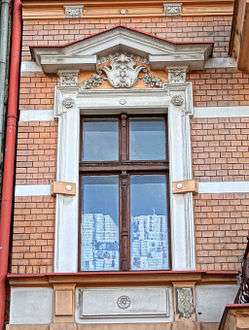 Detail of a window
Detail of a window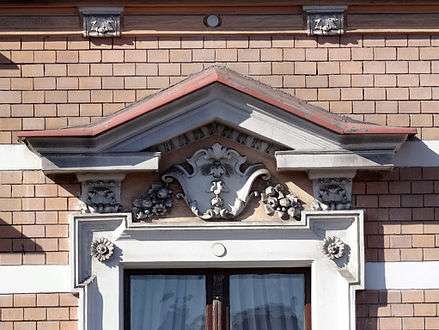 Zoom on a pediment
Zoom on a pediment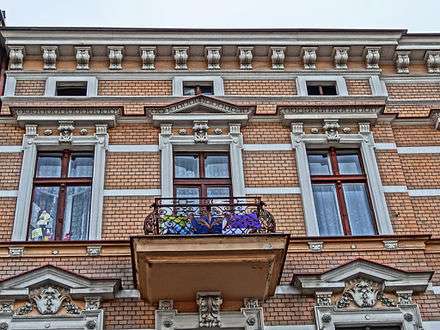 Detail of upper floors
Detail of upper floors
Tenement at N°27
circa 1875[20]
Carl Wilhelm Feyertag, a merchant,[55] was the first owner of this house then at Bahnhoffstraße 11. His widow lived there till the 1910s. Feyertag widow owned also a tenement at Piastkowski Square N°19.
Facade style is inspired by Neoclassical architecture, similar to the neighbouring at N°29. Pilasters underline the symmetry of the elevation, with the balcony in the center.
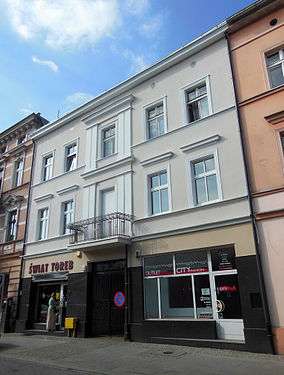 Facade on Dworcowa Street
Facade on Dworcowa Street- Wrought iron Gate
Tenement at N°31
1881,[20] by H. Jenisch & Scheithauer
French and North European Eclecticism
At its inception, the tenement belonged to Franz Marr, a beer dealer,[56] then in 1910 it was the property of Hermann Briebe, a furniture dealer.[57]
The house differs from its neighbours by its height (one additional floor), and by its architecture with more ornaments (pilasters, corbels) and its motifs (garlands, frieze).
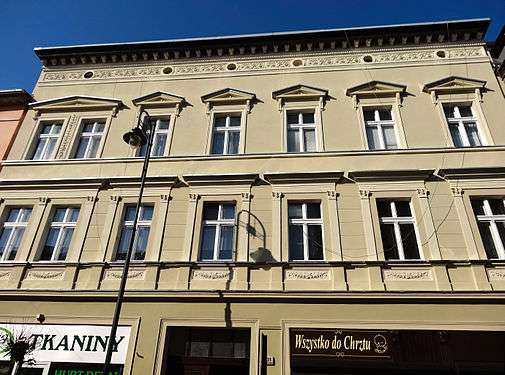 Facade on Dworcowa Street
Facade on Dworcowa Street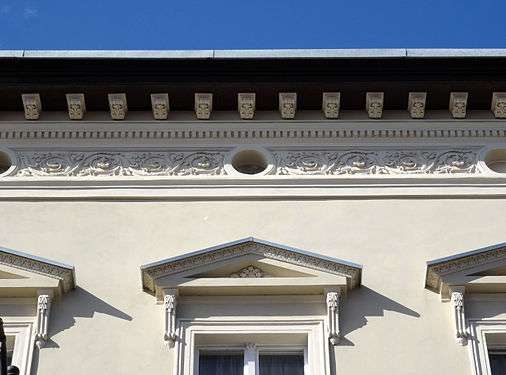 Detail of the frieze and table corbel
Detail of the frieze and table corbel
Antonie Bomrente Tenement, Dworcowa Street N°33
1891[20]
Antonie Bomrente, a cooper,[58] was the first owner of the actual building until World War I. It that was located at Bahnhoffstraße 14: the facade still bears this old number.
Many architectural details are still present on the building: above the gate, dividers, symbol of architecture, are set above a small barrel, recalling the profession of the first landlord. Two slight avant-corps balanced each side of the edifice. On the first floor, the middle part is enhanced by flanking pilasters with rosettes topped by a balustrade. Corbel tables crowns the facade, the ensemble is overlooked by a series of gable wall dormer.
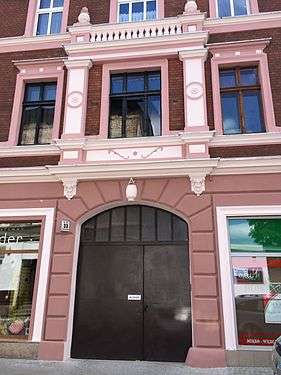 Facade on Dworcowa Stret
Facade on Dworcowa Stret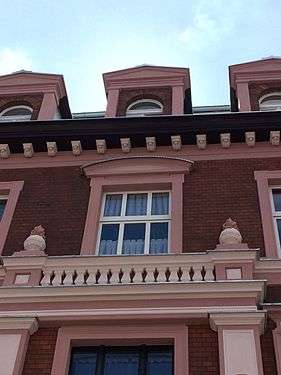 Balustrade and pilasters
Balustrade and pilasters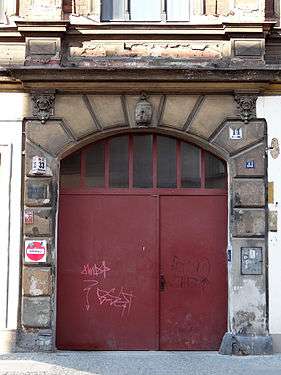 Entry porch, "N°14" is the old Prussian street numeration
Entry porch, "N°14" is the old Prussian street numeration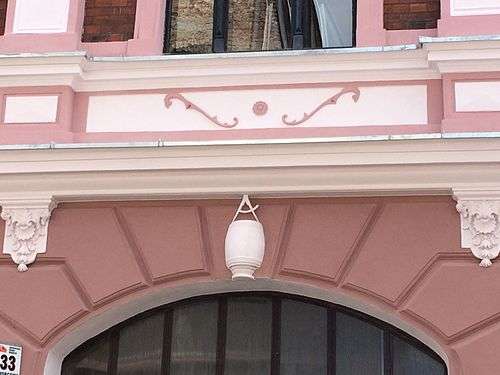 Detail of the portal, with dividers and barrel symbols.
Detail of the portal, with dividers and barrel symbols.
Tenement at N°35
circa 1870
First reference of Bahnhoffstraße 15 is made around 1870, with Louis Gosdynski, a rentier, as owner.[59] In 1900, building's property moved to Wilhelhm Zweiniger, a furrier.
The facade on Dworcowa street shed light on the fact that initially the tenement has been designed as two different houses, N°15 & 15a. There is clearly a divide between the left part bending on Neo-Renaissance style (symmetry, naked walls, flat roof) and the right one inclining on eclecticist diversity (balconies, bossage wall, cartouche decoration, mansard roof).
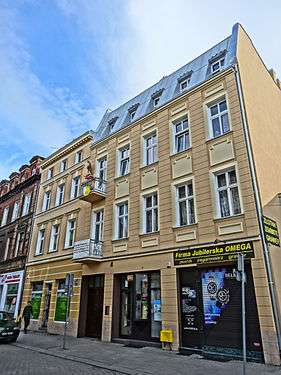 Facade on Dworcowa Street
Facade on Dworcowa Street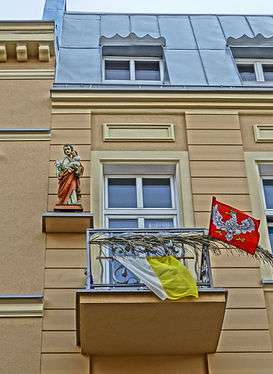 Detail of a balcony
Detail of a balcony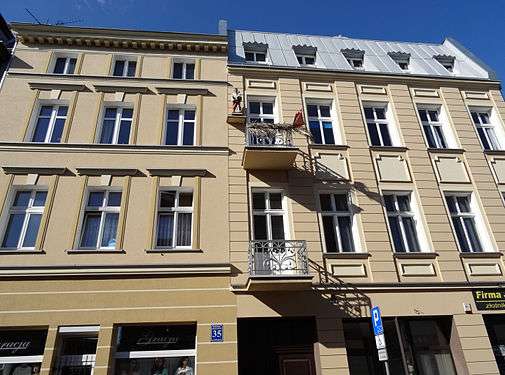 Two facades- two different styles
Two facades- two different styles
Alexsander Theil Tenement, Dworcowa Street N°39 - corner with Marcinkowski street
1890,[20] by Józef Święcicki
The house at Bahnhoffstraße 17 was commissionned by Alexander Theil, a rentier living at Gammstraße 14.[60] The building housed on the ground floor three shops, each with a small apartment in the back and the upper floors accommodated two four-room apartments.[60]
The corner house is remarkable by the ornamental painting between the windows of the first floor of the elevation on Dworcowa street.[61] The edifice is massive, but the richness of its ornaments and motifs help it having a certain lightness.
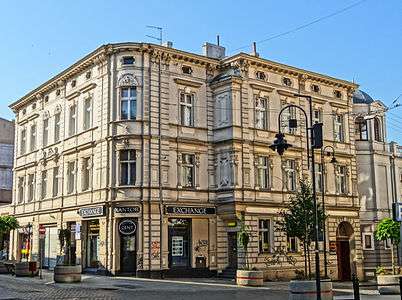 View of the tenement from the street
View of the tenement from the street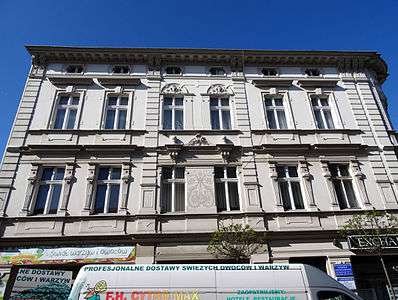 Facade on Dworcowa Street
Facade on Dworcowa Street Detail of the painting on 1st florr
Detail of the painting on 1st florr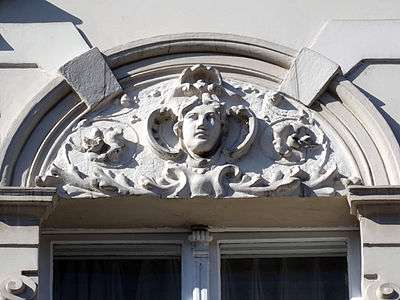 Detail of a pediment
Detail of a pediment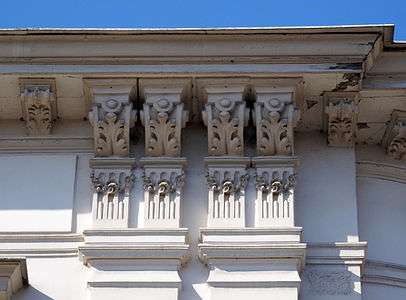 Detail of corbels
Detail of corbels
Tenement at N°41, corner with Marcinkowski street
1904,[20] by Erich Lindenburger
Franz Muhme, a mason, was the first owner of the actual building then at Bahnhoffstraße 18: he was mainly renting rooms.[62] In the 1910s, the house was divided into five entities,[63] which landlords were: Mr. Meyer and Mr Giefe, rentiers not living in Bromberg, Hermann Lemke, a baker who had his shop there, Jahnke Jr., an engineer and Wilhelm Tornow, a mechanic.
Facades, renovated in 2015, have Neo-Baroque and early Modernism elements. The architect varied the effects to render the assymmetry: bay window, corner terrace and balconies, cartouches, eyelid dormer on the corner but a row of shed dormers on the roof giving onto Dworcowa Street. The house lost one of its corner tower during a fire.
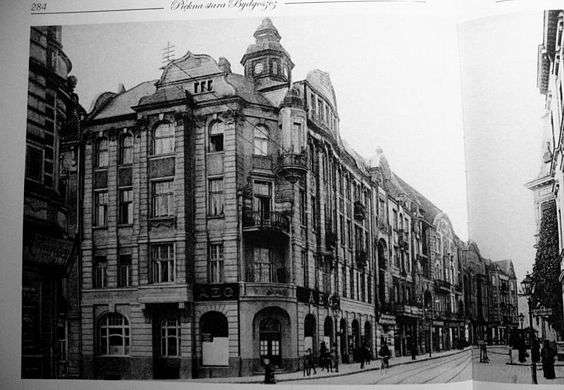 View ca 1930
View ca 1930- Facades on Dworcowa and Marcinkowski Street
- Detail of the corner tower
- Main gate
- Elevation on Dworcowa street
Willy Grawunder Tenement, Dworcowa Street N°45
1906,[20] by Erich Lindenburger
The house, then at Bahnhoffstraße 19, has been commisionned by Willy Grawunder, a merchant running a hardware store/perfumery in the premises.[64]
Facade compositions include loggias and balconies highlighted with wavy ornamented pilasters. The portal is also adorned with a wavy oval, similar to Art Nouveau townhouses in Munich. Eric Lindenburger used similar motifs for house at N°47 and at Adam Mickiewicz N°3.
 Facade on Dworcowa Street
Facade on Dworcowa Street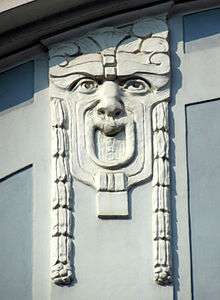 Detail of a masque
Detail of a masque Art Nouveau motifs
Art Nouveau motifs
Bruno Grawunder Tenement, Dworcowa N°47
1906,[65] by Erich Lindenburger
Eclecticism, Munich Secession elements
Bruno Grawunder, a jeweler, supposedly a relative of Wilhelm at N°45, had this house built at Bahnhoffstraße 20.[66]
The compositions on elevation include bow windows topped by balconies, loggias plus especially highlighted cartouches and a grand frieze elements deployed like square boards on top of the facade. Interiors materials are partly original woodwork and stained glass.
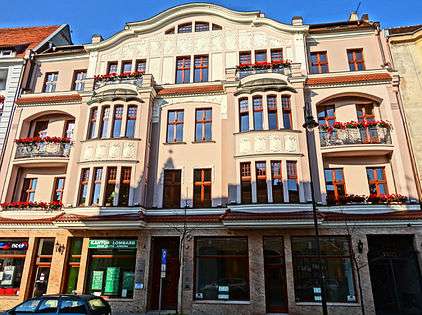 Facade on Dworcowa Street
Facade on Dworcowa Street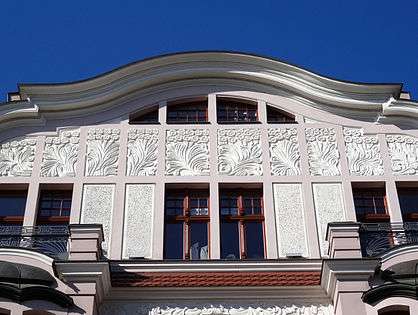 Frieze elements
Frieze elements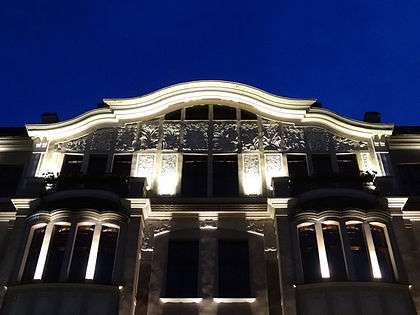 By night
By night
Tenement at N°49
1908[20]
Friedrich Heller, the first owner, was running a wine and spirit shop there (Bahnhoffstraße 21).[67]
The main elevation is remarkable for its wrought iron balconies, and also for the ornamented cartouches on bay windows and facade. Ornaments include figures of woman, stylized lion, garlands and other vegetal motifs specific to Art Nouveau.
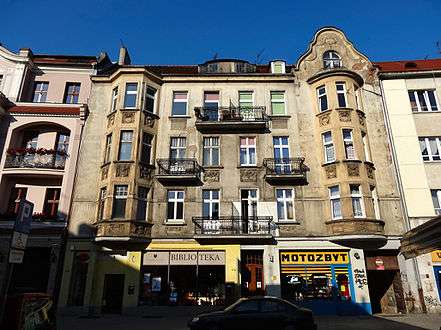 Facade on Dworcowa Street
Facade on Dworcowa Street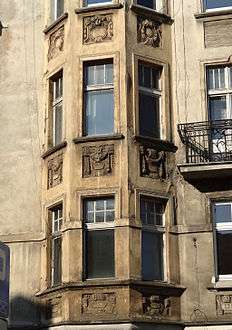 Bay window detail
Bay window detail Motifs
Motifs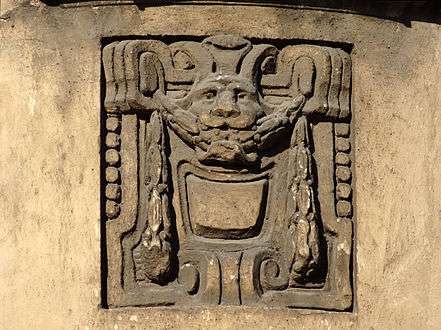 Motif detail
Motif detail
Tenement at N°50, corner with Henryk Sienkiewicz Street
1895[20]
Christian Theodore Hinß has been running a coach workshop (German: Wagenfabrikant) since 1880 there.[68] His relative Carl was landlord till 1917.
Facades display a northern Neo-Renaissance style with elaborate ornament and scrollwork (on pediments, cartouches), balustrades, pinnacles, together with stone blocks imitation, bay windows and a mansard roof.
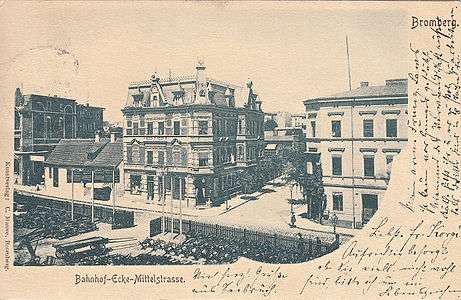 1900 postcard view
1900 postcard view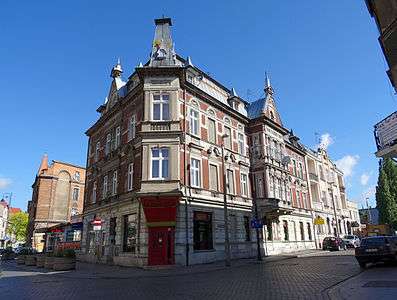 Facades on Dworcowa and Sienkiewicz Streets
Facades on Dworcowa and Sienkiewicz Streets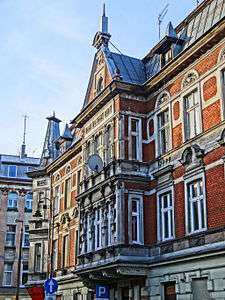 Facade on H. Sienkiewicz Street
Facade on H. Sienkiewicz Street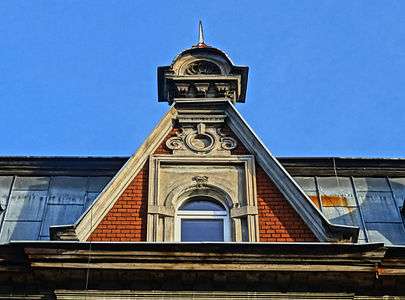 Gable dormer
Gable dormer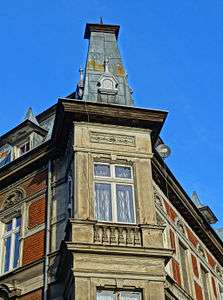 Corner bay window
Corner bay window Windows decoration
Windows decoration
Ludwig Schultz Tenement, Dworcowa Street N°54
1893-1894,[20] by Józef Święcicki
North European Mannerism, forms of Neo-Gothic
The house at Bahnhoffstraße 72 was part of an extensive property, between Dworcowa and Lipowa street which belonged to Ludwig Schultz, co-founder of shipping company Schultz und Winnemer.[69] The firm survived till World War I.
It is an exceptional house with a very narrow body, a side wing with entrance on the it. Most interesting are the arrangement of loggias, pinnacles, narrow and tall windows with small gargoyles to drain the water.[70]
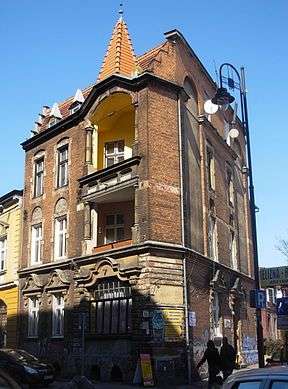 Facade on Dworcowa Street
Facade on Dworcowa Street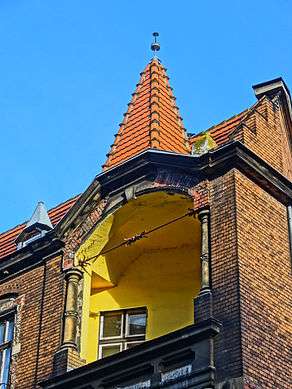 Pinnacle detail
Pinnacle detail
Tenement at N°55/57
1902-1903[20]
German Historicism
Plots situated between Bahnhoffstraße 22 and Bahnhoffstraße 28 (from today 's Dworcowa N°51 to 61) were property of the Prussian Railway Direction (German: Preußische Ostbahn) which had tenements erected to house officials, personnel and administration. The building at N°88/57 wa one of them, realized in the beginning of the 20th century.
The massive building shows balanced facade with two grand bay windows, several balconies and a large terrace running between the gable, beneath dormers. Worth underlining are the two gates adorned with a typical Art Nouveau female figure (N°55) and with vegetal curly scrollwork (N°57).
 View of N°55 (front) and 57 (back)
View of N°55 (front) and 57 (back)- Portal Art nouveau at N°55
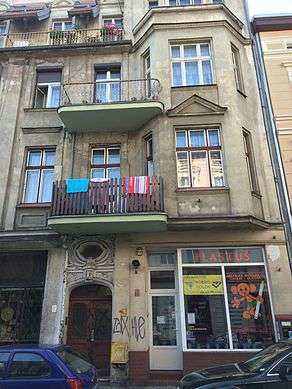 Main elevation at N°57
Main elevation at N°57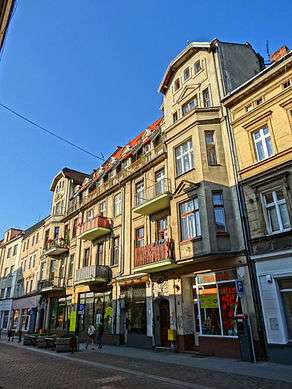 Opposite view, N°57 (front) and N°55 (back)
Opposite view, N°57 (front) and N°55 (back)
Theodore Flöther Tenement, Dworcowa Street N°56
1903-1904[20]
At its inception, landlord of actual tenement (then at Bahnhoffstraße 71) was Theodore Flöther,[71] who was the founder of a firm producing agricultural machines in Jasień, Lubusz Voivodeship.[72] Both the actual building and the neighbouring one (N°58, non existent today) have been used to showcase the production of the factory till end of World War I. In the 1930s, the building housed a coffee shop roasting and grinding coffee, run by W.J. Luczkowski[73]
The ground floor of the edifice still got the large curved glass openings designed for exhibiting machines. First floor windows are framed with delicate ornamentation and scrollwork, especially the larger one on the right, with its early Art Nouveau tympanon motifs inside the triangular pediment.
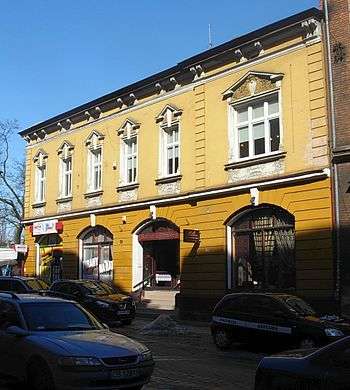 Facade on Dworcowa Street
Facade on Dworcowa Street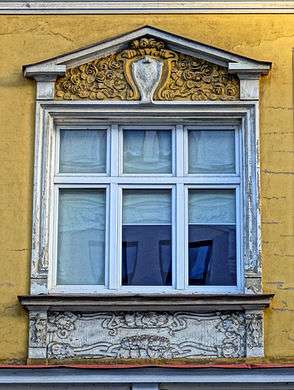 Window detail
Window detail
Tenement at N°61
1876,[20] by Gustaw Weihe
Gustaw Weihe, the architect selected for this building, will be the main designer of Hotel Ratuszowy in Długa street in 1881. The house was first possessed by the Wulf brothers (Adolf & Theodor), factory managers: the also had the adjoining house where the tramway line runs today to the bridge over the Brda.[74] Later, in the 1880s, all plots situated between Bahnhoffstraße 22 and Bahnhoffstraße 28 (from today 's Dworcowa N°51 to 63) were bought by the Prussian Railway Direction (German: Preußische Ostbahn) to house officials, personnel and administration.
The main elevation is influenced by Italian Cinquecento, with its pilastered windows and the triangular pediments. One can also make out fine details, such as scrollworks, lions' heads at the top of the elevation, and a nice row of rosettes just beneath, stretching like a frieze.
 Main facade on Dworcowa Street
Main facade on Dworcowa Street Detail of the upper floors, lion's head and rosettes
Detail of the upper floors, lion's head and rosettes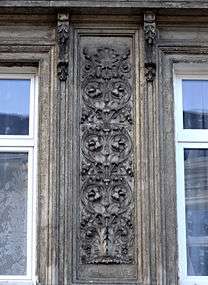 Scrollworks detail
Scrollworks detail
Prussian Eastern Railway Headquarters, Dworcowa Street N°63
Registered on Kuyavian-Pomeranian Voivodeship heritage list, N°601288-Reg.A/748, December 10, 1971[19]
1886-1889[20]
Martin Gropius, Heino Schmieden
Dutch Mannerism
Seat of Prussian Eastern Railway (1889-1895), then regional directorate (1895-1920), Pomeranian rail agency and the Central Bureau of Foreign Settlements (1922-1939), and seat of French-Polish Rail Association (1937-1939).
- View from Dworcowa street
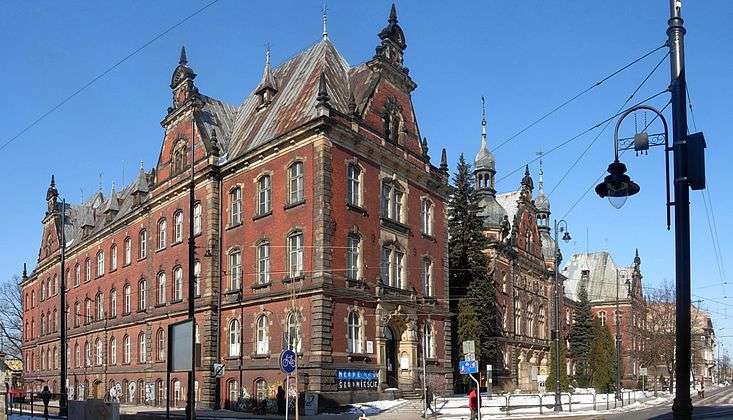 Former Prussian Railways Company building
Former Prussian Railways Company building
State Archives building, Dworcowa Street N°65
1871[20]
First owners of the building, initially a residential one at Bahnhoffstraße 29, were the Wulf brothers (Adolf & Theodor), factory managers and landlords of adjoining plots (N°61 and 63):[74] they had this house built as office and residential building. After the liquidation of their company in 1876, the building has housed in 1886 the General Commission - German: general kommissionsgebäude- conducting land reform in East and West Prussia and in the Grand Duchy of Poznań.[75] Since 1906 it operates as an archive building.[76] At the back of the plot, one can still spot old brick factory buildings from the Wulf brothers' period.[77]
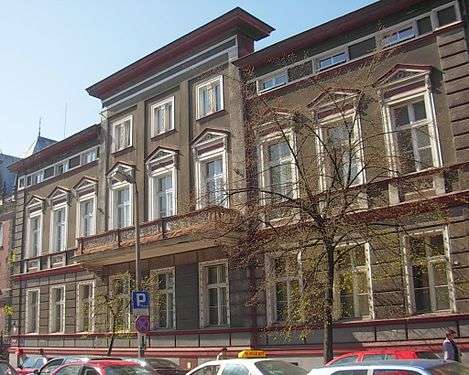 View from Dworcowa street
View from Dworcowa street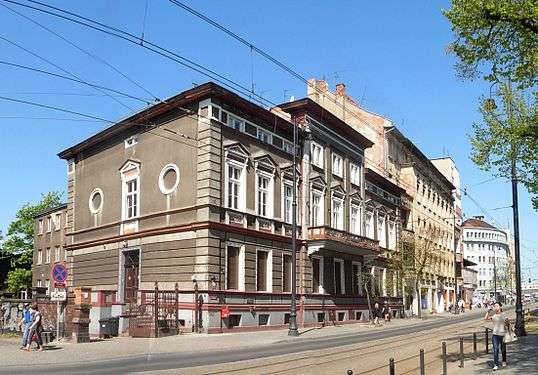 Side view
Side view Detail of balcony
Detail of balcony Windows adornement
Windows adornement.jpg) Old brick factory buildings
Old brick factory buildings
Tenement at N°66
1886,[20] by A. Hardt
Italian Neo-Renaissance
Eduard Greuer, a locksmith was the first landlord of this tenement located at Bahnhoffstraße 66.[78] In the 1910s, the new landlord, Joseph Zawitaj,had a metal moulding workshop there.[79]
The facade displays a typical Neo-Renaissance style, with Italian forms: triangular and curved pediments, cartouches beneath first floor windows, a minute avant-corps and a wrought iron entry gate.
 Facade on Dworcowa Street
Facade on Dworcowa Street
Erick Hecht tenement, Dworcowa Street N°67
1912-1913,[20] by Otto Walter
Erick Hecht, a bookseller[80] who had his shop on Dantzigerstraße N°19, commissionned Berliner architect Otto Walther to design his house at Bahnhoffstraße 30. Otto Walther, at the time, had just finished realizing the department store Jedynak at the crossing with Gdańska Street.
The main elevation is overwhelmed with bas-reliefs, among which:
- A horse rider above the entrance gate;[81]
- A fish, symbolizing the owner, since Hecht means pike in German;
- A 19th-century girl, another with horns, a baby's head, a man with royal attributes;
- A figure supposed to be Lady Godiva.[82]
 Facade on Dworcowa Street
Facade on Dworcowa Street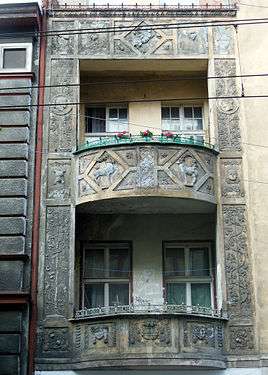 balconies with bas-reliefs
balconies with bas-reliefs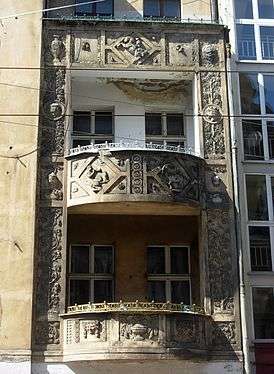 balconies with bas-reliefs
balconies with bas-reliefs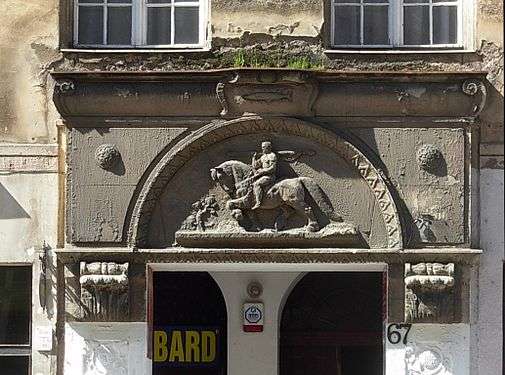 Detail of the tympanum
Detail of the tympanum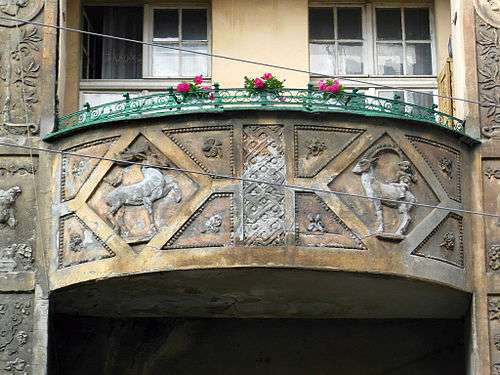 Detail of animal figures
Detail of animal figures
Tenement at N°68
Turn of 20th century,[20] by Karl Bergner
The initial owner of the house at Bahnhoffstraße 65 was Karl Schultz, a metal craftsman.[83] Karl Bergner, a German architect, designed several others buildings in Bydgoszcz, such as in:
- Śniadecki Street at N°6, 10 (his own house), 12;
- Cieszkowski Street at N°7, 9, 14, 16/18/20, 24;
- Foch Street at N°2 and 4.
The building echoes almost perfectly its neighbour at N°66. Same Neo-Renaissance features, identical size and similar architectural motifs.
- View from Dworcowa Street
- Facade detail
- Detail of windows decoration
Hermann Dyck Tenement, Dworcowa street N°71, corner with Krolowa Jadwiga Street
1895-1896,[20] by Fritz Weidner
Hermann Dyck, a merchant selling steam sawmills,[84] had the house at Bahnhoffstraße 31 erected by Fritz Weidner.
Rebuilt entirely in 1956, the facade lost its original Neo-Baroque features.
 The building in the early 20th century
The building in the early 20th century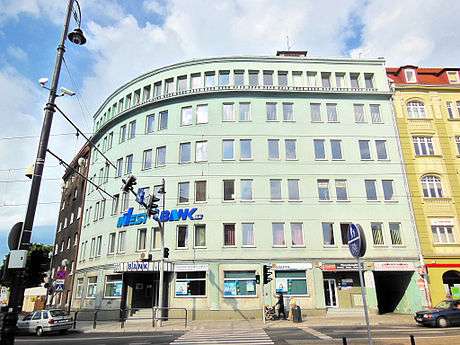 Corner on Dworcowa and Krolowej Jadwigi Street
Corner on Dworcowa and Krolowej Jadwigi Street
Fritz Herold tenement, Dworcowa street N°73
1911-1912,[20] by Otto Müller
Fritz Herold, a rentier, had this building located at Bahnhoffstraße 31a constructed by Otto Müller. He moved there in 1898.[85] Unfortunately, the tenement burned down in 1945.
Urban-type building, the facade displays bay windows and bow windows with an inclination to Art Nouveau: round gable top, vegetal motifs, curved cartouches and adorned gate.
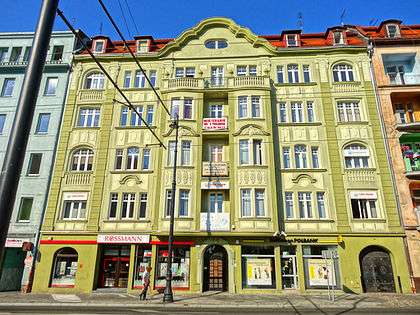 Facade onto Dworcowa Street
Facade onto Dworcowa Street Balcony topping the bay window
Balcony topping the bay window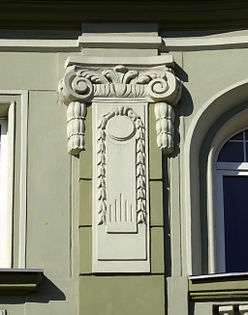 motifs detail
motifs detail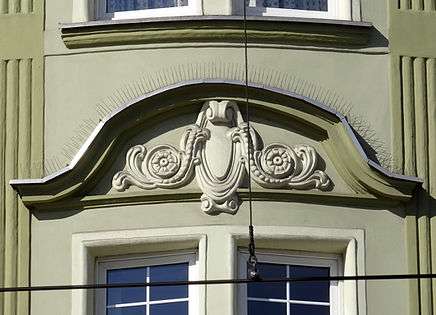 motifs detail
motifs detail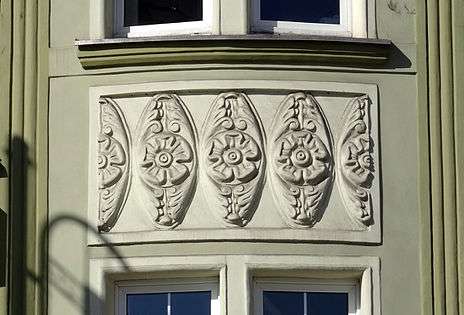 motifs detail
motifs detail
Ernst Baudelow tenement, Dworcowa street N°74 - corner with Jan Matejko street
1895[20]
Ernst Baudelow, a merchant, ordered the construction of this building at the end of the 19th century.[86] Between 1908 and 1925, the tenement, at Bahnhoffstraße 62 was an hotel, "Hotel Darheim".[87]
The edifice is typical of Eclecticism, as one can encounter in downtown Bydgoszcz. The elevation on Dworcowa is characterised by heavy pediments and large wrought iron balconies supported by corbels. On Matejko street, the facade is less adorned.
 Corner house on Dworcowa and Jan Matejko streets
Corner house on Dworcowa and Jan Matejko streets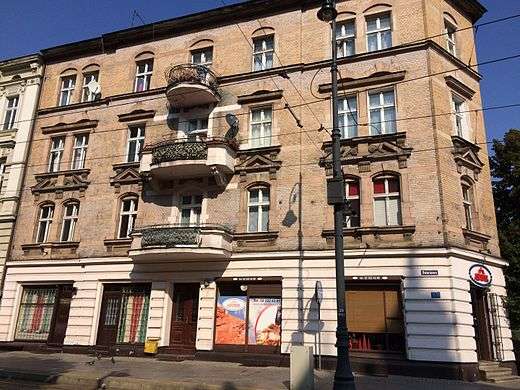 Facade onto Dworcowa
Facade onto Dworcowa balconies on Dworcowa street
balconies on Dworcowa street
Tenement at N°75
1911-1912,[20] by Otto Müller
Richard Hoppe, a preacher,[88] was the owner of this tenement at Bahnhoffstraße 31b. Andrzej Schwalbe, the first director of Pomeranian Philharmonic from 1953 to 1991, lived there. A plaque in memoriam has been unveiled in June 30, 2003.
Few elements survived time, especially the architectural details. Only the decoration of the gate still displays vegetal forms crowned by a coat of arms containing a lamb of God. The rest of the facade is balanced by two bay windows flanked by loggias, with balconies in the middle of the lot.
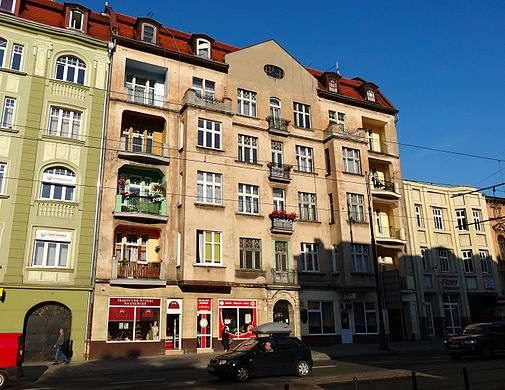 Facade on Dworcowa Street
Facade on Dworcowa Street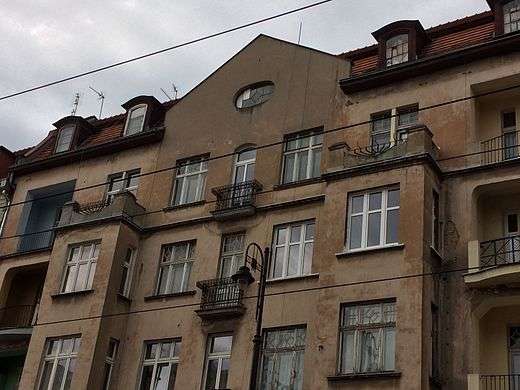 View of the gable
View of the gable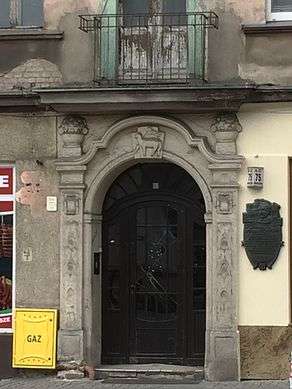 Main gate
Main gate Memorial plaque for Andrzej Szwalbe
Memorial plaque for Andrzej Szwalbe
Tenement at N°76
1860[20]
Eclecticism & Neo-Baroque elements
Joseph Schreiber, a miller, was the first owner of Bahnhoffstraße 61.[89]
Particularly noticeable elements are:
- A highly decorated gate frame, flanked by columns and crowned by a pediment;
- A grand bay window, sheltering a loggia, supported by heavy corbels, surrounded by columns and topped by a small terrace (building).
 Facade on Dworcowa Street
Facade on Dworcowa Street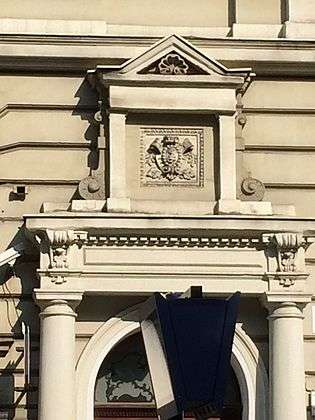 Detail of the adorned gate
Detail of the adorned gate
Albin Cohnfeld tenement, Dworcowa Street N°77
The Cohnfeld family, Gustav then Albin then their heirs, owned the plot at Bahnhoffstraße 32 from before the erection of the present edifice till mid-1910s.[91][92]
The facade has a rich ornamentation typical of the Eclecticism. One can quote, among others, a highly adorned wrought iron balcony and bay window ensemble with sculpted atlants, elaborated ornaments, and a cartouche containing the initials CA for Albin Cohnfeld, commisionner of the building. The entire facade, topped by a table corbel, possess on second and third floors a very rich decoration, with delicate flower and vegetal motifs, in pediments or around the openings. Above the bay window stands an onion dome steeple.
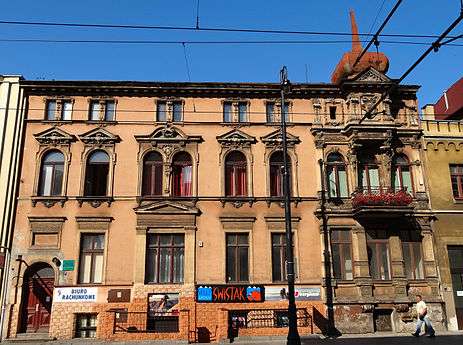 Facade on Dworcowa Street
Facade on Dworcowa Street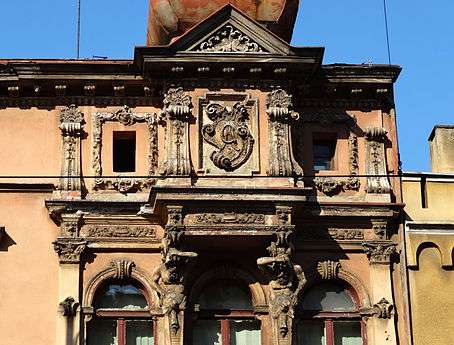 Bay window and initials within the cartouche
Bay window and initials within the cartouche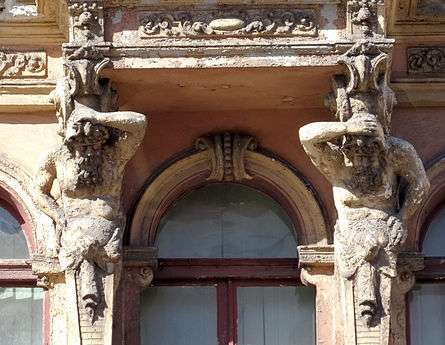
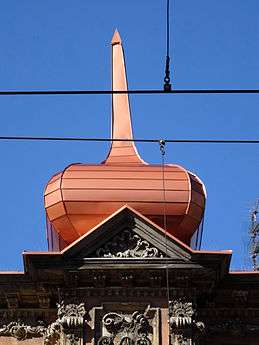
Tenement at N°79, corner with Jan Sobieski Street
1870, 1971[20]
Initially owned by a restaurateur, Gustav Müller,[93] at its erection, the house at Bahnhoffstraße 33 was then bought by Julius Schliep in 1889 to run a hotel Schliep's Hotel.[94] In 1920, new landlord Leon Ciemniak renamed it Hotel International,[95] then Hotel Metropol (1932),[96] and Hotel Asystenta in the 1970s.
The refurbishing of the 1970s gave to the facade forms of Modern architecture. Anyhow, its general shape reveals its old roots (gables type for instance), in a way similar to one of the old house in Gdańska Street (N°37).
 Facade on Dworcowa Street
Facade on Dworcowa Street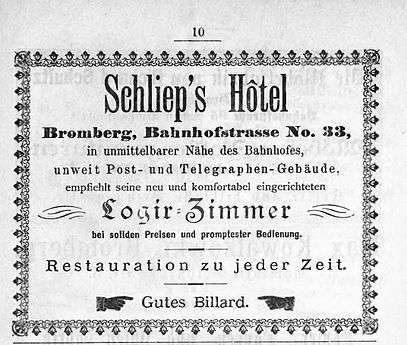 Schliep's hotel advertising in 1894
Schliep's hotel advertising in 1894
Foreign Language Teacher Training College, Dworcowa Street N°80
1891-1892[20]
The building at Bahnhoffstraße 59 has been designed to house the activity of Franz Bengsch,[97] who ran a wood transport company there till the end of World War I. During the interwar period, the tenement was owned by the Ramme Brothers, who had a workshop in Grunwaldzka street for reparing agricultural machines.[98] Since 1990, the building houses the Foreign Language Teacher Training College or NKJO (Polish: Nauczycielskie Kolegium Języków Obcych w Bydgoszczy, subordinated to universities of Poznań and Warsaw. A plaque has been placed on the facade in honor of railway engineer Ernest Malinowski (1818-1899), patron of NKJO Spanish section.
The facade has reminiscences of Neo-Renaissance elements, with its bare wall and the overall symmetry of the ensemble.
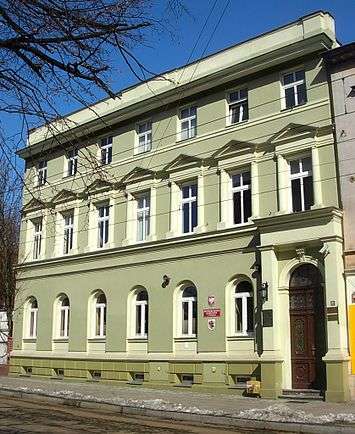 Facade on Dworcowa Street
Facade on Dworcowa Street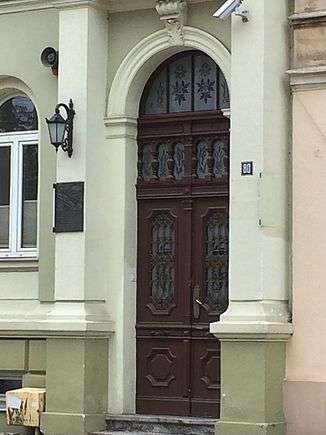 Detail of the gate
Detail of the gate Plaque to Ernest Malinowski's memory.
Plaque to Ernest Malinowski's memory.
Elementary school at N°82
ca 1875[20]
Earliest reference of the building at Bahnhoffstraße 58 can be found in the address book of Bromberg in 1869,[99] where it is described as "Bahnhoffstraße Public school", German: Schule der Bahnhoffstraße. It is then renamed "State school for boys and for girls" (German: Stätische knaben und mädchen Schule) in 1876.[100] After World War I, the building kept its educational aims as "Public school for boys N°1"[101] Today, it is the "Culture house for Youth N°4"' Polish: Młodzieżowy Dom Kultury nr 4.
The house shows early forms of Eclecticism, with references to German Historicism in the display of bricks chosen in two different colors.
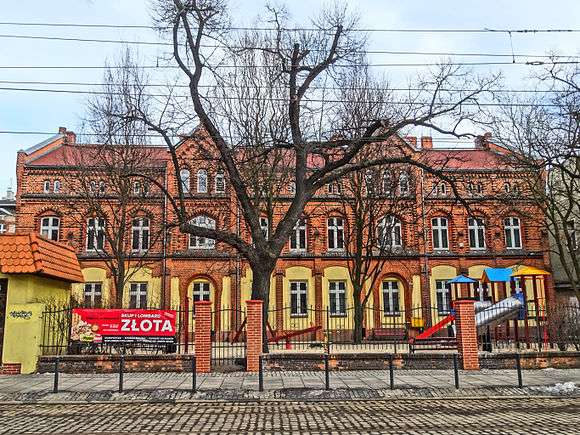 View from Dworcowa Street
View from Dworcowa Street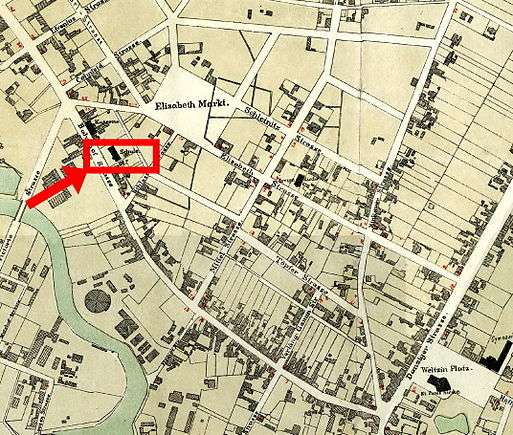 The school on a 1876 map
The school on a 1876 map
Tenement at N°84
1899[20]
Louis Bollmann, founder in 1898 of a brick factory, was the first owner of the tenement[102] then located at Bahnhoffstraße 57 till the 1910s.
The facade is well balanced, with two balconies on each side, with balustrades and wrought iron details. A very large balcony stands in the middle of the elevation, topped by a full row of balusters on the roof. The gate frame is ornamented with columns and a pediment where stands a large sculpture of a sitting crowned lion, holding a coat of arms with shields.
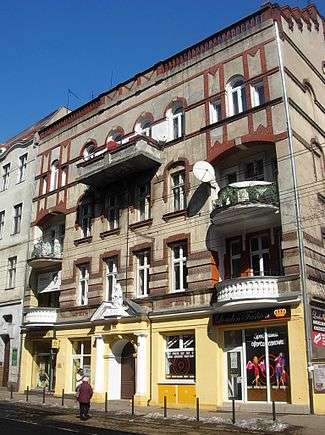 Facade on Dworcowa Street
Facade on Dworcowa Street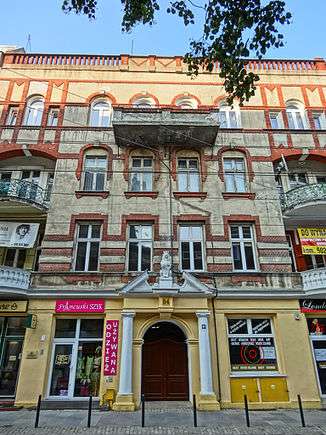 Main elevation detail
Main elevation detail Detail of the entry pediment
Detail of the entry pediment
Hotel Centralny, Dworcowa Street N°85 - corner with Unii Lubelskiej street
1875-1876,[20] by Gustaw Weihe
F.F.A.H. Brennecke, a railway operation controleur,[103] is the first registered owner of the house at Bahnhoffstraße 37. In 1900, it became Hotel Victoria[104] and Hotel "Viktoria" in 1920 run by Jan Draheim.[105] It is still a hotel today, "Hotel Centralny".
The architecture of this corner house is typical of the last quarter of 19th century: a two-storey (plus attic) tenement, with few decoration on the outside, except a frieze running beneath the gable, some shed dormers, and a nicely adorned bay window on the corner. Quite noticeable is the entry in the corner, flanked by two columns.
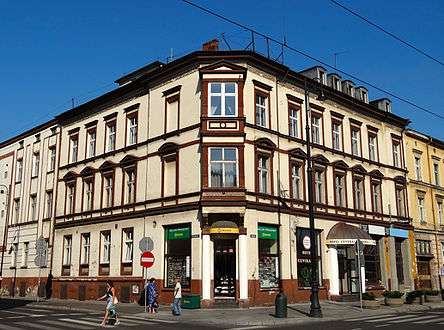 View from Dworcowa Street
View from Dworcowa Street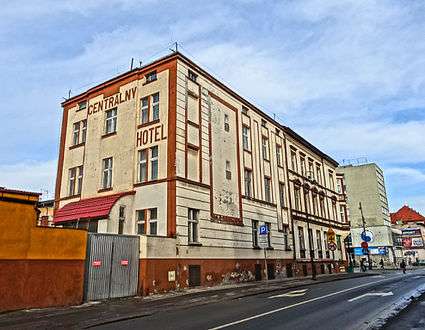 View from Unii Lubelskiej street
View from Unii Lubelskiej street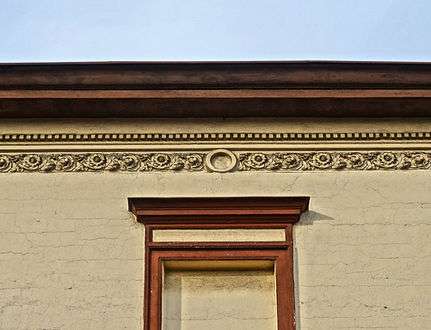 Frieze detail
Frieze detail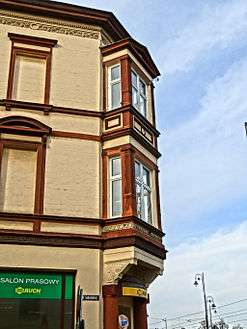 Detail of the corner bay window
Detail of the corner bay window
Heinrich Kirsch tenement, Dworcowa Street N°86
1904,[20] by Rudolf Kern
Heinrich Kirsch was the owner of the newly commissionned house to Rudolf Kern at Bahnhoffstraße 56.[106] He lived there until World War I. At the same time, the architect has been building his own house at Adam Mickiewicz Alley N°1.
The main elevation has suffered from successional renovations that obliterated many architectural details. Be that as it may, the general shape of the building reveals its Art Nouveau inclination: curved shapes of the gable, portals and transom emphasize the Secession inspiration of Rudolf Kern. In addition, the facade strikes by its huge bay window, topped by a balcony.
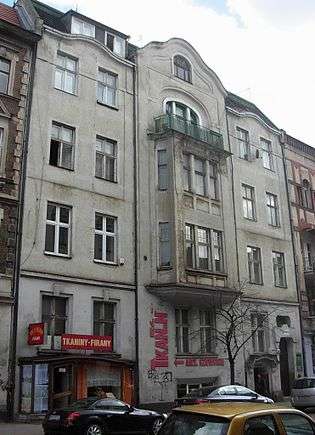 Facade on Dworcowa Street
Facade on Dworcowa Street- Portal on Dworcowa
Tenement at N°87
1889[20]
The tenement at then-Bahnhoffstraße 38, eventhough conceived as an habitation house at its inception in 1876, soon turned to house a hotel: Heise's Hotel in 1876,[107] "Hoffman's Hotel" in 1884[108] then "Gelhorn's Hotel " from 1887 to 1939,[4] period from which the actual building dates back to.
The facade reflects Neo-Renaissance elements, with its bared wall and minimal window decoration. One can notice the original transom above the vehicle entry, on the left of the elevation.
 Facade on Dworcowa Street
Facade on Dworcowa Street
Tenement at N°88
1899[20]
A restaurateur at Bahnhoffstraße 55, Emil Geste, sold in 1899 the tenement[109] to Clara and Reinhold Rosente, wine and delicatessen merchands, who owned already the adjoining house at N°54 (corner with Śniadecki Street).[110]
The facade reflectsnicely Neo-Renaissance style: symmetry of the ensemble (balconies disposition, gates locations), specific decoration of openings per level (pediments with Acanthus or bare). It incorporates somehow Neo-Baroque elements, for instance in the wrought iron balustrade of balconies, or the top curved gable. Worth noticeable is the door gate, delicately adorned, as well as the Hermes figure overlooking the entry.
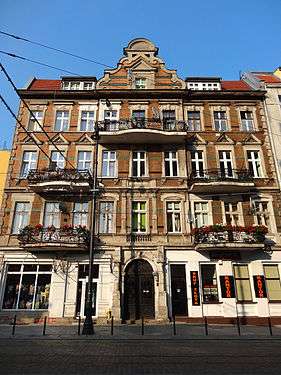 Facade on Dworcowa Street
Facade on Dworcowa Street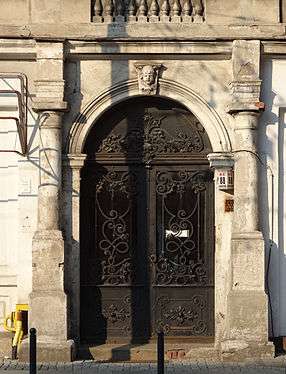 Gate detail
Gate detail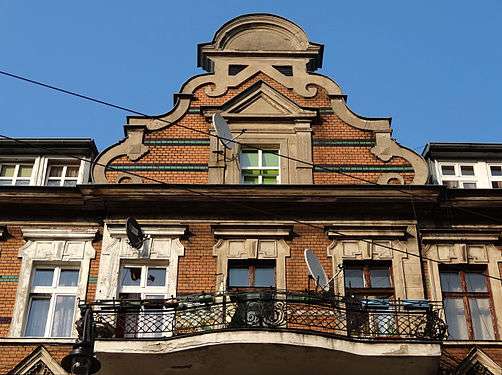 Gable detail
Gable detail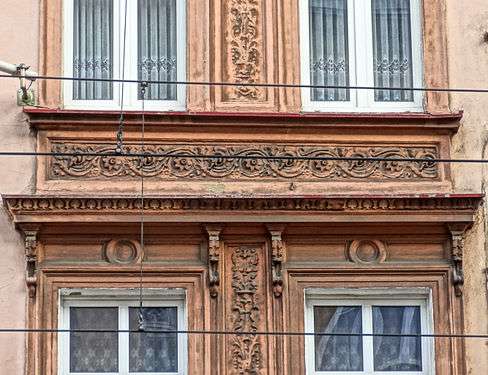 Ornamentation detail
Ornamentation detail
Tenement at N°89, corner with Zygmunt August Street
1870[20]
Friedrich Kalau, mail office director, was the first landlord of house at Bahnhoffstraße 39.[111] The year after, the building became a hotel, "Hotel du Nord".[4] Its name changes several times, "Riller's Hotel" in 1875 and "Gelhorn's Hotel" in 1898 run by Anna and Max Scheidling,[4][112] then by Johannes Bohlmann[113] from the 1910s till World War II.
The facade mirrors neighbouring one at N°87, but for its larger middle balustrade and the position of the entry gate.
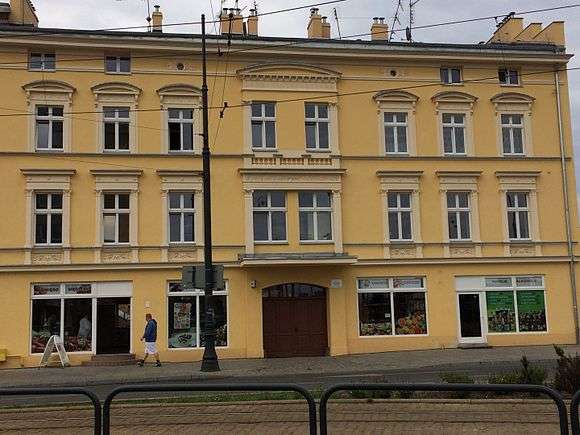 Facade on Dworcowa Street
Facade on Dworcowa Street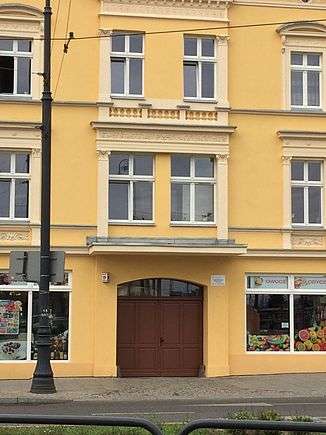 Main gate and bay window
Main gate and bay window
Hotel Brda, Dworcowa Street N°94
1854 & 1972
Before the "Brda hotel" built in 1972, there were "Heise’s Hotel" (1889), "Hotel zur Neue Stadt" (1891) and "Hotel Nowe Miasto" (1920-1922).
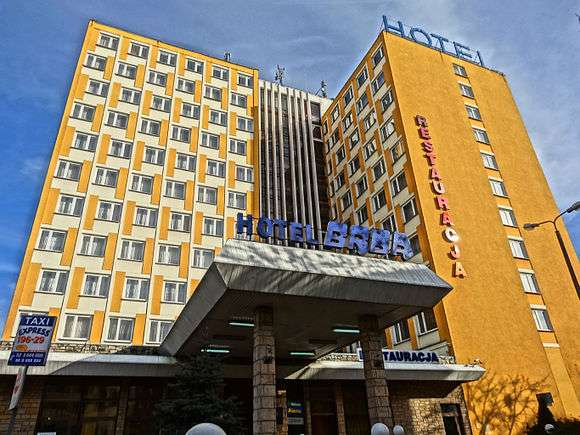 Facade on Dworcowa Street
Facade on Dworcowa Street
Tenement at N°98
1894[20]
The tenement at Bahnhoffstraße 50 was owned by Albin Cohnfeld, a rentier, who lived at Dworcowa Street N°77. He also owned the adjoining house at N°100.[114] Between 1894 and 1937, it housed a Post Office (German: ßostamt).[115]
The facade has a rich decoration, including:
- On the ground floor, bossages and mascarons above each window;
- On the second floor, a wrought iron balcony.
On both levels, opening are topped by pediments. Most remarkable is the delicate bay window prolonged by a loggia with columns on the second floor, capped by a Tented roof steeple.
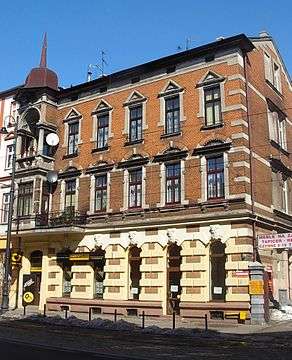 Facade on Dworcowa Street
Facade on Dworcowa Street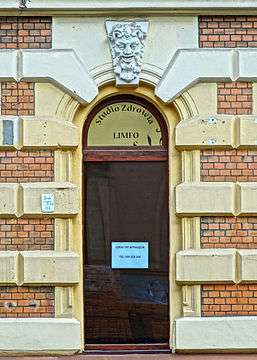 Gate detail
Gate detail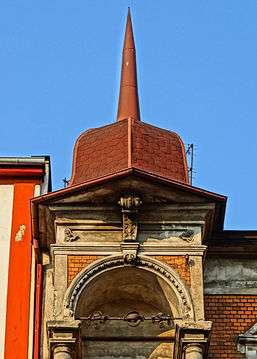 Detail of the steeple
Detail of the steeple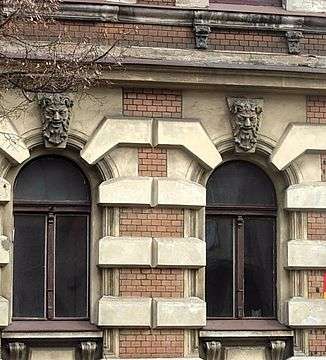 Facade decoration
Facade decoration
Tenement at N°100, corner with Jan III Sobobieski
1870,[20] by Karl Bergner[116]
House at Bahnhoffstraße 49, like the one at Bahnhoffstraße 50 (Dworcowa N°98), was owned since the 1870s] by Albin Cohnfeld, a rentier,[117] who lived at Dworcowa Street N°77. From 1877 to 1886, the building housed an hotel, Hotel St. Petersbur, run by Louis Jacobowski between 1877 and 1886.[118]
The eclectic styled facade has lost almost all of its features with time. Few pediments on second floor windows and a wrought iron entry grille are left.
 Facade on Dworcowa Street
Facade on Dworcowa Street
Main train Station
1851, 1968, 2015
Oldest and largest city railway station, it has undergone a major rebuilding until end of 2015.
- New train station building
 The historical terminal renovated
The historical terminal renovated
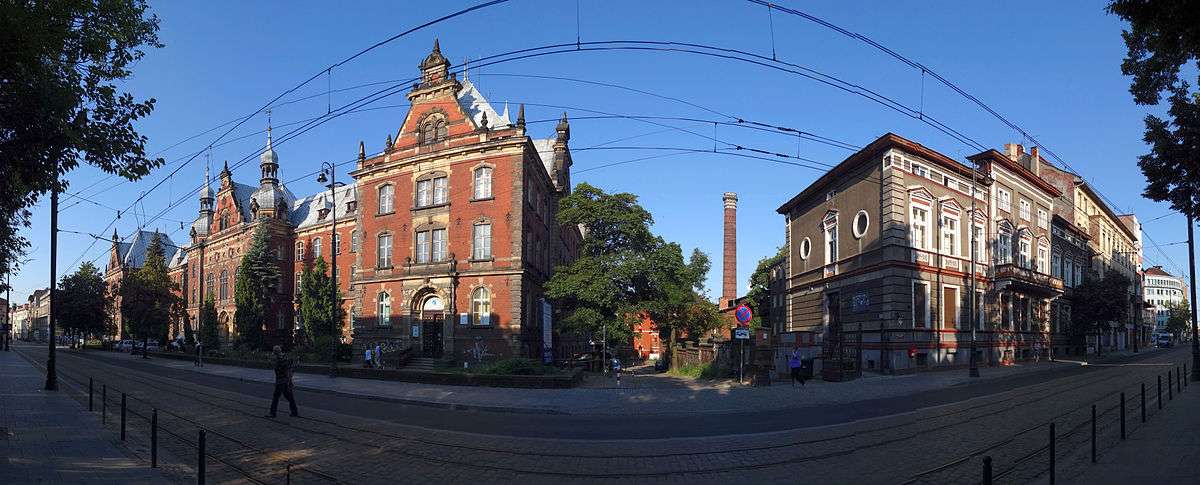
See also
- Gdańska Street
- Freedom Square in Bydgoszcz
- Pomorska Street in Bydgoszcz
- Jan and Jędrzej Śniadecki Street in Bydgoszcz
- (Polish) Downtown district Bydgoszcz
- (Polish) History of Bydgoszcz
External links
- Heavy steel structure factory
- Pizzeria Ambar in Dworcowa street
- Culture house for Youth N°4 at Dworcowa 82
- Hotel Centralny at Dworcowa 85
Bibliography
- (Polish) Derenda Jerzy (red.): Piękna stara Bydgoszcz, Tom I z serii: Bydgoszcz miasto na Kujawach, Towarzystwo Miłośników Miasta Bydgoszczy Bydgoszcz 2006, ISBN 83-916178-0-7, 978-83-916178-0-9, 83-916178-5-8, 978-83-916178-5-4, 83-916178-1-5, 978-83-916178-1-6
- (Polish) Bręczewska-Kulesza, Daria: Przegląd stylów występujących w bydgoskiej architekturze drugiej połowy XIX i początku XX stulecia
- (Polish) Jastrzębska-Puzowska, Iwona: Od miasteczka do metropolii. Rozwój architektoniczny i urbanistyczny Bydgoszczy w latach 1850-1920. Wydawnictwo MADO. Toruń 2005. ISBN 83-89886-38-3, 978-83-89886-38-5
- (Polish) Umiński, Janusz: Bydgoszcz. Przewodnik, Regionalny Oddział PTTK "Szlak Brdy" Bydgoszcz 1996
- (Polish) Derkowska-Kostkowska Bogna, Józef Swiecicki – szkic biografii bydgoskiego budowniczego, Materially do Dziejów Kultury i Sztuki Bydgoszczy i Regionu, zeszyt 6
- (Polish) Daria Bręczewska-Kulesza, Rozwój budownictwa hotelowego w Bydgoszczy w 2. polowie XIX i na początku XX wieku, Materially do Dziejów Kultury i Sztuki Bydgoszczy i Regionu, zeszyt 7
References
- ↑ Gąsiorowski Paweł Bogdan: Bydgoski południk [w:] Kalendarz Bydgoski 2006
- ↑
- ↑ Derenda Jerzy red.: Piękna stara Bydgoszcz. Tom I z serii: Bydgoszcz miasto na Kujawach. Towarzystwo Miłośników Miasta Bydgoszczy. Bydgoszcz 2006. ISBN 83-916178-0-7, 978-83-916178-0-9, 83-916178-5-8, 978-83-916178-5-4, 83-916178-1-5, 978-83-916178-1-6, str. 281
- 1 2 3 4 5 Bręczewska-Kulesza Daria: Rozwój budownictwa hotelowego w Bydgoszczy w 2 połowie XIX i na początku XX wieku, [w:] Materiały do dziejów kultury i sztuki Bydgoszczy i regionu. zeszyt 7. Pracownia Dokumentacji i Popularyzacji Zabytków Wojewódzkiego Ośrodka Kultury w Bydgoszczy Bydgoszcz 2002
- 1 2 http://www.express.bydgoski.pl/look/article.tpl?IdLanguage=17&IdPublication=2&NrIssue=1479&NrSection=80&NrArticle=167053&IdTag=85 dostęp 2-04-2010
- ↑ Adressbuch nebst allgemeinem Geschäfts-Anzeiger von Bromberg und dessen Vororten auf das Jahr 1888 : nach amtlichen Quellen. Bromberg: Dittmann. p. 132.
- ↑ Adressbuch nebst allgemeinem Geschäfts-Anzeiger von Bromberg und dessen Vororten auf das Jahr 1888 : nach amtlichen Quellen. Bromberg: Dittmann. p. 34.
- ↑ Die deutsche Minderheitenpresse in Polen 1918-1939 und ihr Polen- und Judenbild,Beata Dorota Lakeberg, p320
- ↑ such is building at N°55, decorated with a head of Hermes
- ↑ Jastrzębska-Puzowska, Iwona: Od miasteczka do metropolii. Rozwój architektoniczny i urbanistyczny Bydgoszczy w latach 1850-1920, Wydawnictwo MADO Toruń 2005, ISBN 83-89886-38-3, 978-83-89886-38-5
- ↑ dostęp 27-01-2010
- ↑ Czachorowski Antoni red.: Atlas historyczny miast polskich, Tom II Kujawy. Zeszyt I Bydgoszcz, Uniwersytet Mikołaja Kopernika Toruń 1997
- 1 2 3 Bręczewska-Kulesza, Daria: Przegląd stylów występujących w bydgoskiej architekturze drugiej połowy XIX i początku XX stulecia
- ↑ http://www.kobidz.pl/app/site.php5/article/1469/3159.html Rejestr zabytków województwa kujawsko-pomorskiego na stronie http://www.kobidz.pl/app/site.php5/Show/1.html KOBiDZ
- ↑ Bręczewska-Kulesza Daria: Rozwój budownictwa hotelowego w Bydgoszczy w 2. połowie XIX i na początku XX wieku, [w:] Materiały do dziejów kultury i sztuki Bydgoszczy i regionu. Zeszyt 7, Bydgoszcz 2002
- 1 2 Lokalny Program Rewitalizacji dla miasta Bydgoszczy na lata 2007-2015, załącznik 4, strona 19-20
- ↑
- ↑
- 1 2 3 zabytek|kujawsko-pomorskie|issued=01.03.2014
- 1 2 3 4 5 6 7 8 9 10 11 12 13 14 15 16 17 18 19 20 21 22 23 24 25 26 27 28 29 30 31 32 33 34 35 36 37 38 39 40 41 42 43 Gminna Ewidencja Zabytków Miasta Bydgoszczy. [w:] Program Opieki nad Zabytkami miasta Bydgoszczy na lata 2013-2016
- ↑ "straßen". Adressbuch nebst allgemeinem Geschäfts-Anzeiger von Bromberg und dessen Vororten auf das Jahr 1855 auf Grund amtlicher und privater Unterlagen. Bromberg: Dittmann. 1885. p. 4.
- ↑ "straßen". Adressbuch nebst allgemeinem Geschäfts-Anzeiger von Bromberg und dessen Vororten auf Grund amtlicher und privater Unterlagen. Bromberg: Dittmann. 1908. p. 340.
- ↑ "straßen". Adressbuch nebst allgemeinem Geschäfts-Anzeiger von Bromberg und dessen Vororten auf Grund amtlicher und privater Unterlagen. Bromberg: Dittmann. 1915. p. 325.
- ↑ "Alphabetisches berzeichnis". Adressbuch nebst allgemeinem Geschäfts-Anzeiger von Bromberg und dessen Vororten auf Grund amtlicher und privater Unterlagen. Bromberg: Dittmann. 1894. p. 146.
- ↑ "Straßen". Adressbuch nebst allgemeinem Geschäfts-Anzeiger von Bromberg und dessen Vororten auf Grund amtlicher und privater Unterlagen. Bromberg: Dittmann. 1897. p. 62.
- ↑ "Alphabetische Verzeichnis". Adressbuch nebst allgemeinem Geschäfts-Anzeiger von Bromberg und dessen Vororten auf Grund amtlicher und privater Unterlagen. Bromberg: Dittmann. 1889. p. 104.
- ↑ "Alphabetische Verzeichnis". Adressbuch nebst allgemeinem Geschäfts-Anzeiger von Bromberg und dessen Vororten auf Grund amtlicher und privater Unterlagen. Bromberg: Mittler. 1872. p. 75.
- ↑ "Alphabetische Verzeichnis". Adressbuch nebst allgemeinem Geschäfts-Anzeiger von Bromberg und dessen Vororten auf Grund amtlicher und privater Unterlagen. Bromberg: Dittmann. 1917. p. 143.
- ↑ "Alphabetische Verzeichnis". Adressbuch nebst allgemeinem Geschäfts-Anzeiger von Bromberg und dessen Vororten auf Grund amtlicher und privater Unterlagen. Bromberg: Louis Levis. 1869. p. 67.
- ↑ "Alphabetische Verzeichnis". Adressbuch nebst allgemeinem Geschäfts-Anzeiger von Bromberg und dessen Vororten auf Grund amtlicher und privater Unterlagen. Bromberg: Mittler. 1872. p. 80.
- ↑ "Alphabetische Verzeichnis". Adressbuch nebst allgemeinem Geschäfts-Anzeiger von Bromberg und dessen Vororten auf Grund amtlicher und privater Unterlagen. Bromberg: Dittmann. 1894. p. 126.
- ↑ "V. Hotels". Adressbuch nebst allgemeinem Geschäfts-Anzeiger von Bromberg und dessen Vororten auf Grund amtlicher und privater Unterlagen. Bromberg: Dittmann. 1910. p. 523.
- 1 2 "Bydgoskie Fabryki Mebli S.A. - 125 lat historii". Gazeta Pomorska. gazeta Pomorska. 8 April 2009. Retrieved 23 January 2016.
- ↑ "Bydgoskie Fabryki Mebli S.A.". Bydgoskie Fabryki Mebli S.A. Bydgoskie Fabryki Mebli S.A. 2016. Retrieved 23 February 2016.
- ↑ "Around the city centre". visitbydgoszcz.pl. Bydgoskie Centrum Informacji. 2016. Retrieved 23 January 2016.[)]
- ↑ "Dworcowa 13". dworcowa 13.pl. APRO Investment Sp. z o. o. 2016. Retrieved 23 January 2016.
- ↑ "Alphabetische Verzeichnis". Adressbuch nebst allgemeinem Geschäfts-Anzeiger von Bromberg und dessen Vororten auf Grund amtlicher und privater Unterlagen. Bromberg: Dittmann. 1910. p. 440.
- ↑ "Alphabetische Verzeichnis". Adressbuch nebst allgemeinem Geschäfts-Anzeiger von Bromberg und dessen Vororten auf Grund amtlicher und privater Unterlagen. Bromberg: Dittmann. 1900. p. 216.
- ↑ "Alphabetische Verzeichnis". Adressbuch nebst allgemeinem Geschäfts-Anzeiger von Bromberg und dessen Vororten auf Grund amtlicher und privater Unterlagen. Bromberg: Mittler. 1878. p. 135.
- ↑ "Alphabetische Verzeichnis". Adressbuch nebst allgemeinem Geschäfts-Anzeiger von Bromberg und dessen Vororten auf Grund amtlicher und privater Unterlagen. Bromberg: Louis Levis. 1869. p. 81.
- ↑ "Kugelfallmühle von Hermann Löhnert, Bromberg". Deutsche digitale bibliothek.de. Deutsche digitale bibliothek. 2016. Retrieved 25 January 2016.
- ↑ "About Us". makrum.pl. Makrum. 2016. Retrieved 25 January 2016.
- ↑ "Kiedyś to była fabryka fabryk". express.bydgoski.pl. Express Bydgoski. 2013. Retrieved 25 January 2016.
- ↑ "Straßen". Adressbuch nebst allgemeinem Geschäfts-Anzeiger von Bromberg und dessen Vororten auf Grund amtlicher und privater Unterlagen. Bromberg: Louis Levis. 1880. p. 41.
- ↑ "Alphabetische Verzeichnis". Adressbuch nebst allgemeinem Geschäfts-Anzeiger von Bromberg und dessen Vororten auf Grund amtlicher und privater Unterlagen. Bromberg: Dittmann. 1911. p. 545.
- ↑ "Dzial Informacyjny". Adresy Miasta Bydgoszczy. 1922. p. 39.
- ↑ "Dzial Informacyjny". Ksiazka Adresowa Miasta Bydgoszczy. 193. p. 16.
- ↑ "Alphabetische Verzeichnis". Adressbuch nebst allgemeinem Geschäfts-Anzeiger von Bromberg und dessen Vororten auf Grund amtlicher und privater Unterlagen. Bromberg: Mittler. 1872. p. 22.
- ↑ "Straßen". Adressbuch nebst allgemeinem Geschäfts-Anzeiger von Bromberg und dessen Vororten auf Grund amtlicher und privater Unterlagen. Bromberg: Dittmann. 1910.
- ↑ "Straßen". Adressbuch nebst allgemeinem Geschäfts-Anzeiger von Bromberg und dessen Vororten auf Grund amtlicher und privater Unterlagen. Bromberg: Mittler. 1872. p. 105.
- ↑ Advertisement in 1890 Addressbook
- ↑ "Alphabetische Verzeichnis". Adressbuch nebst allgemeinem Geschäfts-Anzeiger von Bromberg und dessen Vororten auf Grund amtlicher und privater Unterlagen. Bromberg: Aronsohn. 1855. p. 14.
- ↑ "Alphabetische Verzeichnis". Adressbuch nebst allgemeinem Geschäfts-Anzeiger von Bromberg und dessen Vororten auf Grund amtlicher und privater Unterlagen. Bromberg: Dittmann. 1894. p. 96.
- ↑ "Ku radości życia...". wspominajbydgoszcz.blogspot. blogger.com. 2016. Retrieved 26 January 2016.
- ↑ "Alphabetische Verzeichnis". Adressbuch nebst allgemeinem Geschäfts-Anzeiger von Bromberg und dessen Vororten auf Grund amtlicher und privater Unterlagen. Bromberg: Mittler. 1876. p. 17.
- ↑ "Alphabetische Verzeichnis". Adressbuch nebst allgemeinem Geschäfts-Anzeiger von Bromberg und dessen Vororten auf Grund amtlicher und privater Unterlagen. Bromberg: Mittler. 1882. p. 71.
- ↑ "Alphabetische Verzeichnis". Adressbuch nebst allgemeinem Geschäfts-Anzeiger von Bromberg und dessen Vororten auf Grund amtlicher und privater Unterlagen. Bromberg: Dittmann. 1910.
- ↑ "Alphabetische Verzeichnis". Adressbuch nebst allgemeinem Geschäfts-Anzeiger von Bromberg und dessen Vororten auf Grund amtlicher und privater Unterlagen. Bromberg: Dittmann. 1892. p. 265.
- ↑ "Alphabetische Verzeichnis". Adressbuch nebst allgemeinem Geschäfts-Anzeiger von Bromberg und dessen Vororten auf Grund amtlicher und privater Unterlagen. Bromberg: Mittler. 1872. p. 23.
- 1 2 "Alphabetische Verzeichnis". Adressbuch nebst allgemeinem Geschäfts-Anzeiger von Bromberg und dessen Vororten auf Grund amtlicher und privater Unterlagen. Bromberg: Dittmann. 1891. p. 215.
- ↑ "Bydgoszczulica Dworcowa 39". Bydgoszcz Józefa Święcickiego. Katarzyna Gwincińska. 2011. Retrieved 27 February 2016.
- ↑ "Alphabetische Verzeichnis". Adressbuch nebst allgemeinem Geschäfts-Anzeiger von Bromberg und dessen Vororten auf Grund amtlicher und privater Unterlagen. Bromberg: Dittmann. 1906. p. 138.
- ↑ "Straßen". Adressbuch nebst allgemeinem Geschäfts-Anzeiger von Bromberg und dessen Vororten auf Grund amtlicher und privater Unterlagen. Bromberg: Dittmann. 1910. p. 7.
- ↑ "Alphabetische Verzeichnis". Adressbuch nebst allgemeinem Geschäfts-Anzeiger von Bromberg und dessen Vororten auf Grund amtlicher und privater Unterlagen. Bromberg: Dittmann. 1907. p. 266.
- ↑ "Świetlisty dom przy Dworcowej". express.bydgoski.pl. express.bydgoski. 2011. Retrieved 28 February 2016.
- ↑ "Alphabetische Verzeichnis". Adressbuch nebst allgemeinem Geschäfts-Anzeiger von Bromberg und dessen Vororten auf Grund amtlicher und privater Unterlagen. Bromberg: Dittmann. 1906. p. 62.
- ↑ "Alphabetische Verzeichnis". Adressbuch nebst allgemeinem Geschäfts-Anzeiger von Bromberg und dessen Vororten auf Grund amtlicher und privater Unterlagen. Bromberg: Dittmann. 1908. p. 303.
- ↑ "Straßen". Adressbuch nebst allgemeinem Geschäfts-Anzeiger von Bromberg und dessen Vororten auf Grund amtlicher und privater Unterlagen. Bromberg: Mittler. 1880. p. 11.
- ↑ "Alphabetische Verzeichnis". Adressbuch nebst allgemeinem Geschäfts-Anzeiger von Bromberg und dessen Vororten auf Grund amtlicher und privater Unterlagen. Bromberg: Dittmann. 1895. p. 11.
- ↑ "Bydgoszczulica Dworcowa 54". Bydgoszcz Józefa Święcickiego. Katarzyna Gwincińska. 2011. Retrieved 28 February 2016.
- ↑ "Alphabetische Verzeichnis". Adressbuch nebst allgemeinem Geschäfts-Anzeiger von Bromberg und dessen Vororten auf Grund amtlicher und privater Unterlagen. Bromberg: Dittmann. 1904. p. 46.
- ↑ "Th. Flöther Fabryka Maszyn Rolniczych". jasien.eu. jasien.eu. 2013. Retrieved 28 February 2016.
- ↑ Advertisement in a 1929 Address Book of Bydgoszcz
- 1 2 "Alphabetische Verzeichnis". Adressbuch nebst allgemeinem Geschäfts-Anzeiger von Bromberg und dessen Vororten auf Grund amtlicher und privater Unterlagen. Bromberg: Mittler. 1878. p. 132.
- ↑ Czachorowski, Antoni (1997). Atlas historyczny miast polskich, Tom II Kujawy. Zeszyt I Bydgoszcz. Toruń: Uniwersytet Mikołaja Kopernika Toruń.
- ↑ "Historia". Archiwum Państwowe w Bydgoszczy. biuletyn informacji publicznej. 2016. Retrieved 20 March 2016.
- ↑ Derkowska-Kostkowska, Bogna (2000). DZIEJE I ARCHITEKTURA BYDGOSKICH FABRYK. Kalendarz Bydgoski. Bydgoszcz: Towarzystwo Miłośników Miasta Bydgoszczy.
- ↑ "Alphabetische Verzeichnis". Adressbuch nebst allgemeinem Geschäfts-Anzeiger von Bromberg und dessen Vororten auf Grund amtlicher und privater Unterlagen. Bromberg: Dittmann. 1887. p. 52.
- ↑ "Alphabetische Verzeichnis". Adressbuch nebst allgemeinem Geschäfts-Anzeiger von Bromberg und dessen Vororten auf Grund amtlicher und privater Unterlagen. Bromberg: Dittmann. 1910. p. 501.
- ↑ "Alphabetische Verzeichnis". Adressbuch nebst allgemeinem Geschäfts-Anzeiger von Bromberg und dessen Vororten auf Grund amtlicher und privater Unterlagen. Bromberg: Dittmann. 1915. p. 302.
- ↑ Małgorzata Czajkowska, Aleksandra Lewińska (2014). "Imponująca kamienica w centrum miasta pójdzie pod młotek". Wyborcza.pl. bydgoszcz.wyborcza. Retrieved March 2016. Check date values in:
|access-date=(help) - ↑ Aleksandra Lewińska (2013). "Ile zawdzięczamy niemieckim architektom". Wyborcza.pl. bydgoszcz.wyborcza. Retrieved 20 March 2016.
- ↑ "Alphabetische Verzeichnis". Adressbuch nebst allgemeinem Geschäfts-Anzeiger von Bromberg und dessen Vororten auf Grund amtlicher und privater Unterlagen. Bromberg: Dittmann. 1895. p. 161.
- ↑ "Alphabetische Verzeichnis". Adressbuch nebst allgemeinem Geschäfts-Anzeiger von Bromberg und dessen Vororten auf Grund amtlicher und privater Unterlagen. Bromberg: Dittmann. 1897. p. 38.
- ↑ "Alphabetische Verzeichnis". Adressbuch nebst allgemeinem Geschäfts-Anzeiger von Bromberg und dessen Vororten auf Grund amtlicher und privater Unterlagen. Bromberg: Dittmann. 1898. p. 70.
- ↑ "Straßen". Adressbuch nebst allgemeinem Geschäfts-Anzeiger von Bromberg und dessen Vororten auf Grund amtlicher und privater Unterlagen. Bromberg: Dittmann. 1915. p. 12.
- ↑ "Alphabetische Geordneter Nachweis". Adressbuch nebst allgemeinem Geschäfts-Anzeiger von Bromberg und dessen Vororten auf Grund amtlicher und privater Unterlagen. Bromberg: Dittmann. 1910. p. 522.
- ↑ "Alphabetische Verzeichnis". Adressbuch nebst allgemeinem Geschäfts-Anzeiger von Bromberg und dessen Vororten auf Grund amtlicher und privater Unterlagen. Bromberg: Dittmann. 1915. p. 313.
- ↑ "Alphabetische Verzeichnis". Adressbuch nebst allgemeinem Geschäfts-Anzeiger von Bromberg und dessen Vororten auf Grund amtlicher und privater Unterlagen. Bromberg: Louis Levit. 1864. p. 58.
- ↑ Bydgoszcz Guide. Bydgoszcz: City of Bydgoszcz. July 2014. p. 107. ISBN 83-917786-7-3.
- ↑ "Alphabetische Verzeichnis". Adressbuch nebst allgemeinem Geschäfts-Anzeiger von Bromberg und dessen Vororten auf Grund amtlicher und privater Unterlagen. Bromberg: Mittler. 1878.
- ↑ "Alphabetische Verzeichnis". Adressbuch nebst allgemeinem Geschäfts-Anzeiger von Bromberg und dessen Vororten auf Grund amtlicher und privater Unterlagen. Bromberg: Dittmann. 1915.
- ↑ "Alphabetische Verzeichnis". Adressbuch nebst allgemeinem Geschäfts-Anzeiger von Bromberg und dessen Vororten auf Grund amtlicher und privater Unterlagen. Bromberg: Mittler. 1872. p. 53.
- ↑ "Alphabetische Geordneter Nachweis". Adressbuch nebst allgemeinem Geschäfts-Anzeiger von Bromberg und dessen Vororten auf Grund amtlicher und privater Unterlagen. Bromberg: Dittmann. 1910. p. 523.
- ↑ "Spis alfabetyczny poszczególnych branż.". Książka Adresowa Miasta Bydgoszczy. 1928. p. 17.
- ↑ "Spis alfabetyczny poszczególnych branż.". Książka Adresowa Miasta Bydgoszczy. 1933. p. 16.
- ↑ "Alphabetische Verzeichnis". Adressbuch nebst allgemeinem Geschäfts-Anzeiger von Bromberg und dessen Vororten auf Grund amtlicher und privater Unterlagen. Bromberg: Dittmann. 1893. p. 14.
- ↑ "Alfabetyczny spis mieszkańców miasta Bydgoszczy". Książka Adresowa Miasta Bydgoszczy. 1933. p. 253.
- ↑ "Alphabetische Geordneter Nachweis". Adressbuch nebst allgemeinem Geschäfts-Anzeiger von Bromberg und dessen Vororten auf Grund amtlicher und privater Unterlagen. Bromberg: Louis Levis. 1869.
- ↑ "Alphabetische Geordneter Nachweis". Adressbuch nebst allgemeinem Geschäfts-Anzeiger von Bromberg und dessen Vororten auf Grund amtlicher und privater Unterlagen. Bromberg: Mittler. 1876.
- ↑ "Spis alfabetyczny poszczególnych branż.". Książka Adresowa Miasta Bydgoszczy. 1933.
- ↑ "Alphabetische Verzeichnis". Adressbuch nebst allgemeinem Geschäfts-Anzeiger von Bromberg und dessen Vororten auf Grund amtlicher und privater Unterlagen. Bromberg: Dittmann. 1901. p. 17.
- ↑ "Alphabetische Verzeichnis". Adressbuch nebst allgemeinem Geschäfts-Anzeiger von Bromberg und dessen Vororten auf Grund amtlicher und privater Unterlagen. Bromberg: Mittler. 1878. p. 13.
- ↑ "Straßen". Adressbuch nebst allgemeinem Geschäfts-Anzeiger von Bromberg und dessen Vororten auf Grund amtlicher und privater Unterlagen. Bromberg: Dittmann. 1900. p. 11.
- ↑ "Spis alfabetyczny poszczególnych branż.". Książka Adresowa Miasta Bydgoszczy. 1922. p. 32.
- ↑ "Alphabetische Verzeichnis". Adressbuch nebst allgemeinem Geschäfts-Anzeiger von Bromberg und dessen Vororten auf Grund amtlicher und privater Unterlagen. Bromberg: Dittmann. 1905. p. 95.
- ↑ "Straßen". Adressbuch nebst allgemeinem Geschäfts-Anzeiger von Bromberg und dessen Vororten auf Grund amtlicher und privater Unterlagen. Bromberg: Mittler. 1878. pp. III.
- ↑ "Straßen". Adressbuch nebst allgemeinem Geschäfts-Anzeiger von Bromberg und dessen Vororten auf Grund amtlicher und privater Unterlagen. Bromberg: Dittmann. 1884. pp. V.
- ↑ "Alphabetische Verzeichnis". Adressbuch nebst allgemeinem Geschäfts-Anzeiger von Bromberg und dessen Vororten auf Grund amtlicher und privater Unterlagen. Bromberg: Dittmann. 1899. p. 53.
- ↑ "Alphabetische Verzeichnis". Adressbuch nebst allgemeinem Geschäfts-Anzeiger von Bromberg und dessen Vororten auf Grund amtlicher und privater Unterlagen. Bromberg: Dittmann. 1900. p. 168.
- ↑ "Alphabetische Verzeichnis". Adressbuch nebst allgemeinem Geschäfts-Anzeiger von Bromberg und dessen Vororten auf Grund amtlicher und privater Unterlagen. Bromberg: Mittler. 1872. p. 34.
- ↑ "Alphabetische Verzeichnis". Adressbuch nebst allgemeinem Geschäfts-Anzeiger von Bromberg und dessen Vororten auf Grund amtlicher und privater Unterlagen. Bromberg: Dittmann. 1905. p. 186.
- ↑ "Alphabetische Verzeichnis". Adressbuch nebst allgemeinem Geschäfts-Anzeiger von Bromberg und dessen Vororten auf Grund amtlicher und privater Unterlagen. Bromberg: Dittmann. 1915. p. 237.
- ↑ "Alphabetische Verzeichnis". Adressbuch nebst allgemeinem Geschäfts-Anzeiger von Bromberg und dessen Vororten auf Grund amtlicher und privater Unterlagen. Bromberg: Dittmann. 1895. p. 28.
- ↑ Winter Piotr: Dawne bydgoskie budynki pocztowe i z pocztą związane, [w:] Materiały do Dziejów Kultury i Sztuki Bydgoszczy i regionu, zeszyt 2, Pracownia Dokumentacji i Popularyzacji Zabytków Wojewódzkiego Ośrodka Kultury w Bydgoszczy 1997
- ↑ Bydgoszcz Guide. Bydgoszcz: City of Bydgoszcz. July 2014. p. 103. ISBN 83-917786-7-3.
- ↑ "Straßen". Adressbuch nebst allgemeinem Geschäfts-Anzeiger von Bromberg und dessen Vororten auf Grund amtlicher und privater Unterlagen. Bromberg: Mittler. 1872. pp. III.
- ↑ "Alphabetische Verzeichnis". Adressbuch nebst allgemeinem Geschäfts-Anzeiger von Bromberg und dessen Vororten auf Grund amtlicher und privater Unterlagen. Bromberg: Mittler. 1880. p. 54.
